A Novel Rectangular-Section Combined Beam of Welded Thin-Walled H-Shape Steel/Camphor Pine Wood: The Bending Performance Study
Abstract
:1. Introduction
2. Materials and Methods
2.1. Design of Test Specimen
2.2. Test Piece Production
2.3. Loading Test
3. Results and Discussion
3.1. Loading Test and Destruction Process
3.2. Mid-Span Cross-Section Strain
3.3. Cross-Span Section Load–Strain Relationship
3.4. Overall Deformation
3.5. Load–Cross Deflection Relationship
4. The Results of the Effective Factors
4.1. Effect of Welding Thin-Walled H-Shape Steel
4.2. Influence of the Flange Thickness of Welded Thin-Walled H-Shape Steel
4.3. Effect of the Upper Flange Thickness
5. Finite Element Parameter and Results Comparison
5.1. Finite Element Model Establishment
5.1.1. Basic Assumptions and Material Constitutive Relationship
- (1)
- Basic assumption
- The wood when pulled and pressed; There was no relative sliding between;
- Steel and wood; without considering the influence of slip;
- The influence of residual stress and residual deformation was not considered during steel welding;
- The natural defects, creep, and stress relaxation of the wood itself were not considered.
- (2)
- Steel constitutive structure
- (3)
- Wood constitutionality
5.1.2. Material Properties
5.1.3. Model Establishment
5.1.4. Grid Division
5.1.5. Definition of Interface Interactions
5.1.6. Boundary Conditions and Loads
5.2. Results of Finite Element Calculation
5.2.1. The Stress Process of Components
5.2.2. The Change in Component Deflection in the Span
5.2.3. The Combined Beam Load–Span Medium Deflection during the Simulation and Experiments
5.3. Main Factors in the Combined Beam Bending Performance
5.3.1. Influence of Steel Yield Strength
5.3.2. Influence of the Flange Thickness of Type Steel H-Beam
5.3.3. Effect of the H-Type Steel Web Thickness
5.3.4. Influence of the H-Type Steel Web Height
5.3.5. The Thickness of Steel H-Beam
5.3.6. Effect of the Composite Beam Section Width
6. Conclusions
- (1)
- The combined beam can be roughly divided into three stages from loading to destruction: elastic stage, elastic–plastic stage, and destruction stage. The final damage is caused by the yielding of the steel section, the yielding of the wood in the compression zone, and the maximum tensile strength of the wood in the tension zone, and the wood is damaged by the tensile break.
- (2)
- The overall deformation curve of the combined beam shows that the deflection in the span of the pure bending section is always the largest during the loading process. The gluing connection between steel and wood is very reliable, the deformation of both is coordinated, and the combined effect is significant.
- (3)
- Improving the yield strength of steel can effectively improve the flexural load-carrying capacity of the combined beam. the thickness of the H-beam flange has a significant improvement in the maximum load-carrying capacity. The effect of web thickness is smaller. the height of the H-beam web has obvious improvement on the combined beam bearing capacity. The maximum bearing capacity is increased by increasing the thickness of the cladding plate on the flange of the H-beam. The width of the combined beam has less effect on the bearing capacity.
Author Contributions
Funding
Institutional Review Board Statement
Informed Consent Statement
Data Availability Statement
Conflicts of Interest
References
- Chen, S. Talk about green and environmental protection building materials. Sci. Technol. Entrep. Mon. 2010, 23, 118–119. [Google Scholar]
- Zhou, R.; Qing, L. Green environmental building materials and their application. Resour. Inf. Eng. 2017, 32, 82–83. [Google Scholar]
- Zhang, J.; Gu, L. The development status, challenges and policy suggestions of green building in China. Energy China 2012, 34, 19–24. [Google Scholar]
- Chau, C.K.; Hui, W.K.; Ng, W.Y.; Powell, G. Assessment of CO2 emissions reduction in high-rise concrete office buildings using different material use options. Resour. Conserv. Recycl. 2012, 61, 22–34. [Google Scholar] [CrossRef]
- Wang, S.; Zhou, C.; Li, G.; Feng, K. CO2, economic growth, and energy consumption in China’s provinces: Investigating the spatiotemporal and econometric characteristics of China’s CO2 emissions. Ecol. Indic. 2016, 69, 184–195. [Google Scholar] [CrossRef]
- Ramage, M.H.; Burridge, H.; Busse-Wicher, M.; Fereday, G.; Reynolds, T.; Shah, D.U.; Wu, G.; Yu, L.; Fleming, P.; Densley-Tingley, D.; et al. The wood from the trees: The use of timber in construction. Renew. Sustain. Energy Rev. 2017, 68, 333–359. [Google Scholar] [CrossRef]
- Akbarnezhad, A.; Jianzhuang, X. Estimation and Minimization of Embodied Carbon of Buildings: A Review. Buildings 2017, 7, 5. [Google Scholar] [CrossRef]
- Chiniforush, A.A.; Akbarnezhad, A.; Valipour, H.; Xiao, J. Energy implications of using steel-timber composite (STC) elements in buildings. Energy Build. 2018, 176, 203–215. [Google Scholar] [CrossRef]
- Borri, A.; Corradi, M. Strengthening of timber beams with high strength steel cords. Compos. Part B Eng. 2011, 42, 1480–1491. [Google Scholar] [CrossRef]
- Nadir, Y.; Nagarajan, P.; Ameen, M.; Arif, M.M. Flexural stiffness and strength enhancement of horizontally glued laminated wood beams with GFRP and CFRP composite sheets. Constr. Build. Mater. 2016, 112, 547–555. [Google Scholar] [CrossRef]
- Hassanieh, A.; Valipour, H.; Bradford, M. Experimental and numerical investigation of short-term behaviour of CLT-steel composite beams. Eng. Struct. 2017, 144, 43–57. [Google Scholar] [CrossRef]
- Shekarchi, M.; Oskouei, A.V.; Raftery, G.M. Flexural behavior of timber beams strengthened with pultruded glass fiber reinforced polymer profiles. Compos. Struct. 2020, 241, 112062. [Google Scholar] [CrossRef]
- Ghanbari-Ghazijahani, T.; Russo, T.; Valipour, H.R. Lightweight timber I-beams reinforced by composite materials. Compos. Struct. 2020, 233, 111579. [Google Scholar] [CrossRef]
- Dar, A.R. An experimental study on the flexural behavior of cold-formed steel composite beams. Mater. Today Proc. 2020, 27 (Pt 1) Pt 1, 340–343. [Google Scholar] [CrossRef]
- Pan, F.T.; Kou, L.; Wang, C.Y. Mechanical Properties Analysis of Steel-Timber Combined Member. Adv. Mater. Res. 2012, 347–353, 1477. [Google Scholar] [CrossRef]
- Fujita, M.; Iwata, M. Bending Test of the Composite Steel-Timber Beam. Appl. Mech. Mater. 2013, 351–352, 415–421. [Google Scholar] [CrossRef]
- Hassanieh, A.; Valipour, H.R.; Bradford, M.A. Experimental and numerical study of steel-timber composite (STC) beams. J. Constr. Steel Res. 2016, 122, 367–378. [Google Scholar] [CrossRef]
- McConnell, E.; McPolin, D.; Taylor, S. Post-tensioning of glulam timber with steel tendons. Constr. Build. Mater. 2014, 73, 426–433. [Google Scholar] [CrossRef]
- Denghui, L. Study on Bending Properties of Steel-Wood Composite Beam. Master’s Thesis, Beijing Jiaotong University, Beijing, China, 2016. [Google Scholar]
- Yushun, L.; Jialiang, Z.; Xiuhua, Z.; Yu, W.; Jun, G. Study on bond stress and bond slip of bamboo-steel interface under static load. J. Build. Struct. 2015, 36, 114–123. [Google Scholar]
- Aiguo, C.; Teng-Hui, L.; Chao, F.; Qingguo, Z.; Jihui, X. Experimental study on flexural behavior of H-shaped steel-wood composite beams. J. Build. Struct. 2016, 37 (Suppl. 1), 261–267. [Google Scholar]
- Xianzhe, W. Study on Flexural Capacity of Thin-Walled Flitch Filled Rectangular Steel Tube Composite Beams. Master’s Thesis, Southwest University of Science and Technology, Mianyang, China, 2018. [Google Scholar]
- Ye, Z.; Feiyang, X.; Hongda, Y.; Xinmiao, M.; Ying, G. Experimental Study and Finite Element Analysis of Steel and Wood Combined Beam under Centralized load. J. Beijing For. Univ. 2021, 43, 127–136. [Google Scholar]
- Degui, L.; Yuhao, W.; Yong, W.; Wei, Z.; Tao, W. Study on the bending properties of thin-wall H-steel-wood composite beam. J. Build. Struct. 2022, 43(05), 149–163. [Google Scholar]
- Zhang, X.; Zhang, Y.; Xie, X. Experimental and analytical investigation of the flexural behaviour of stiffened hollow glulam beams reinforced with fibre reinforced polymer. Structures 2023, 50, 810–822. [Google Scholar] [CrossRef]
- Chen, Y.X. Flexural Analysis and Design of Timber Strengthened with High-Strength Composites. Ph.D. Thesis, Rutgers The State University of New Jersey, New Brunswick, NJ, USA, 2003. [Google Scholar]
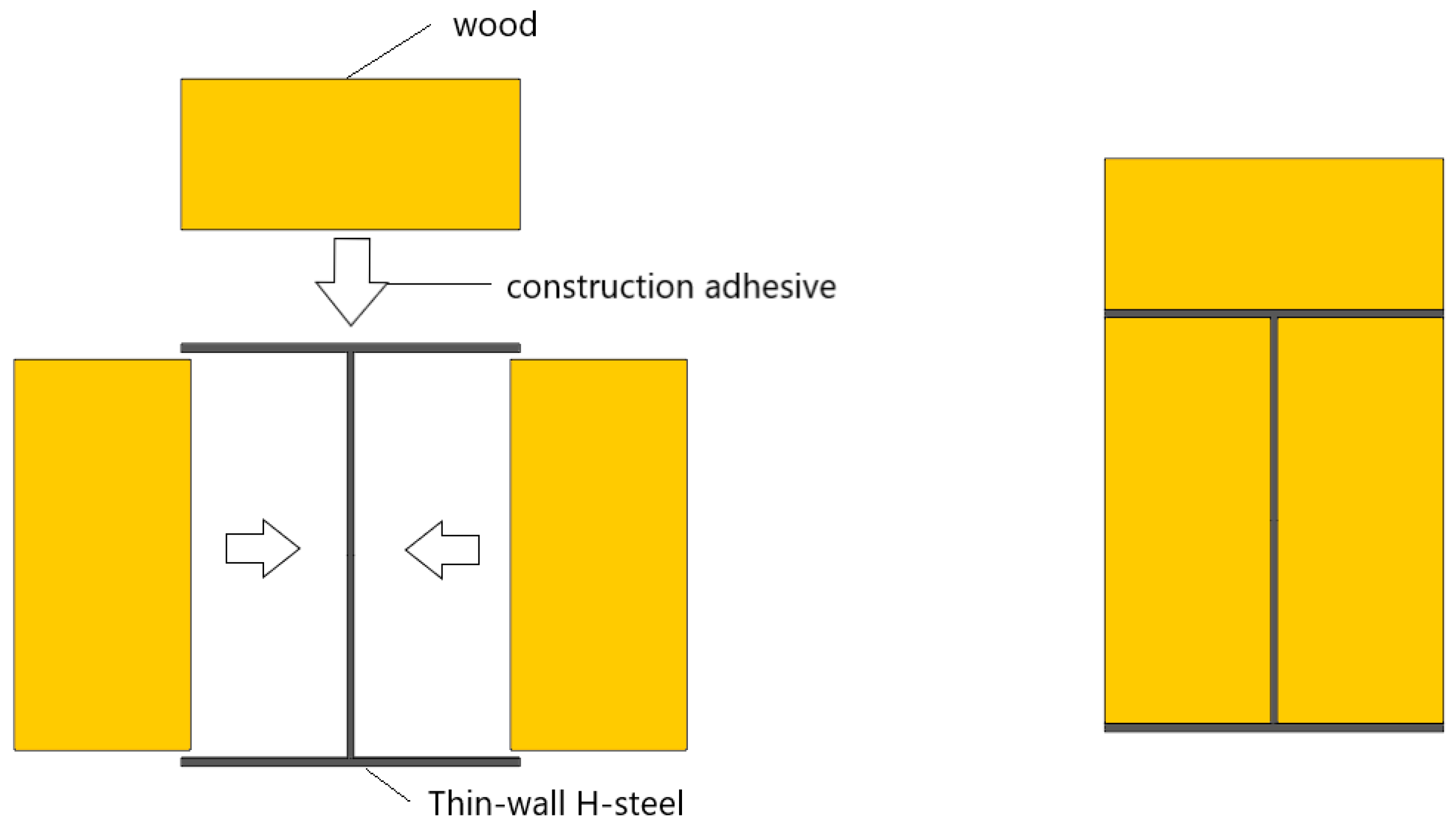
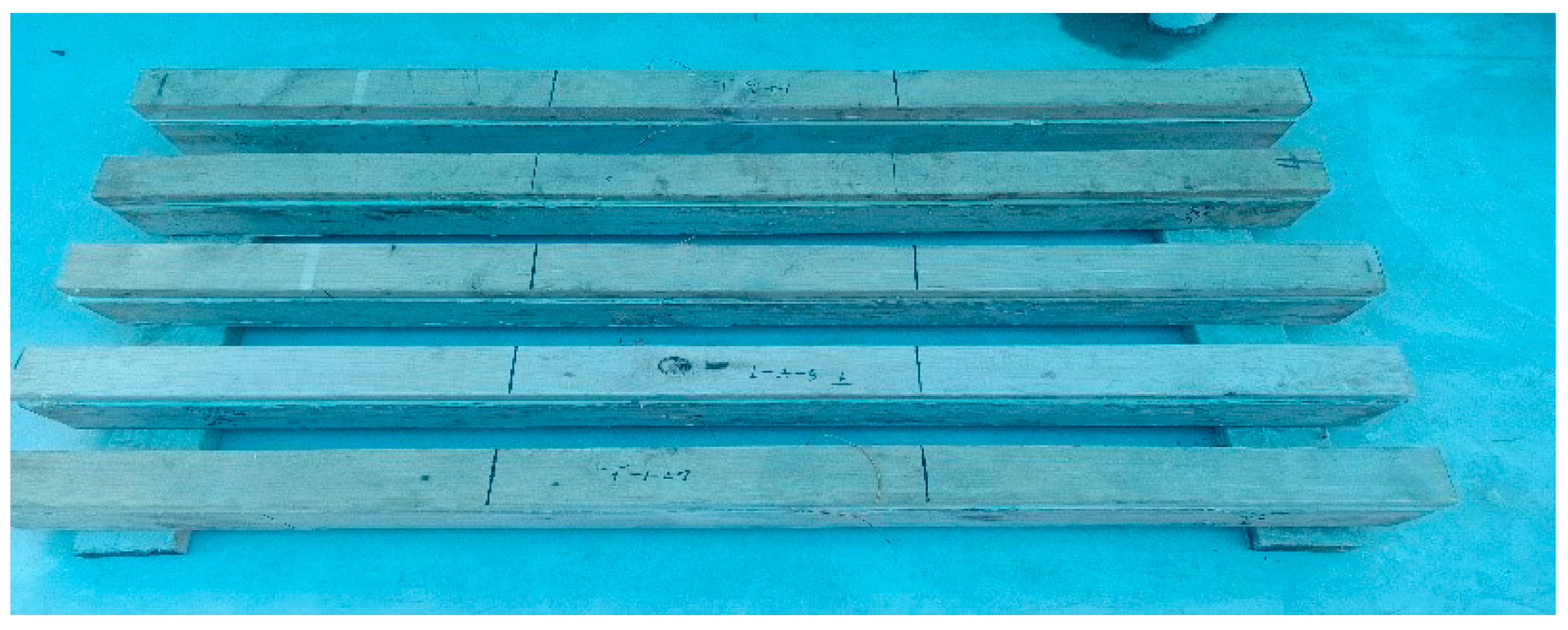
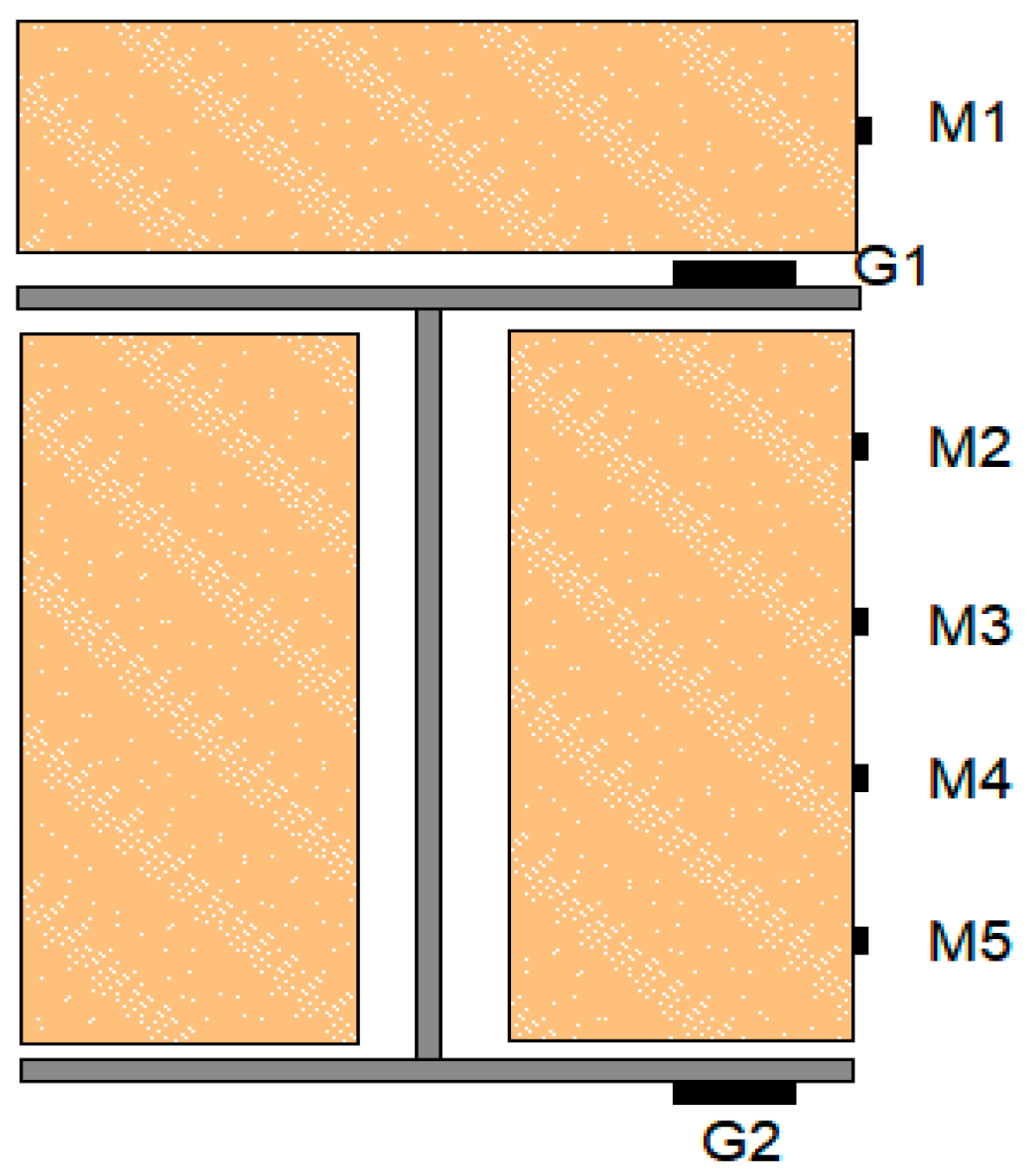
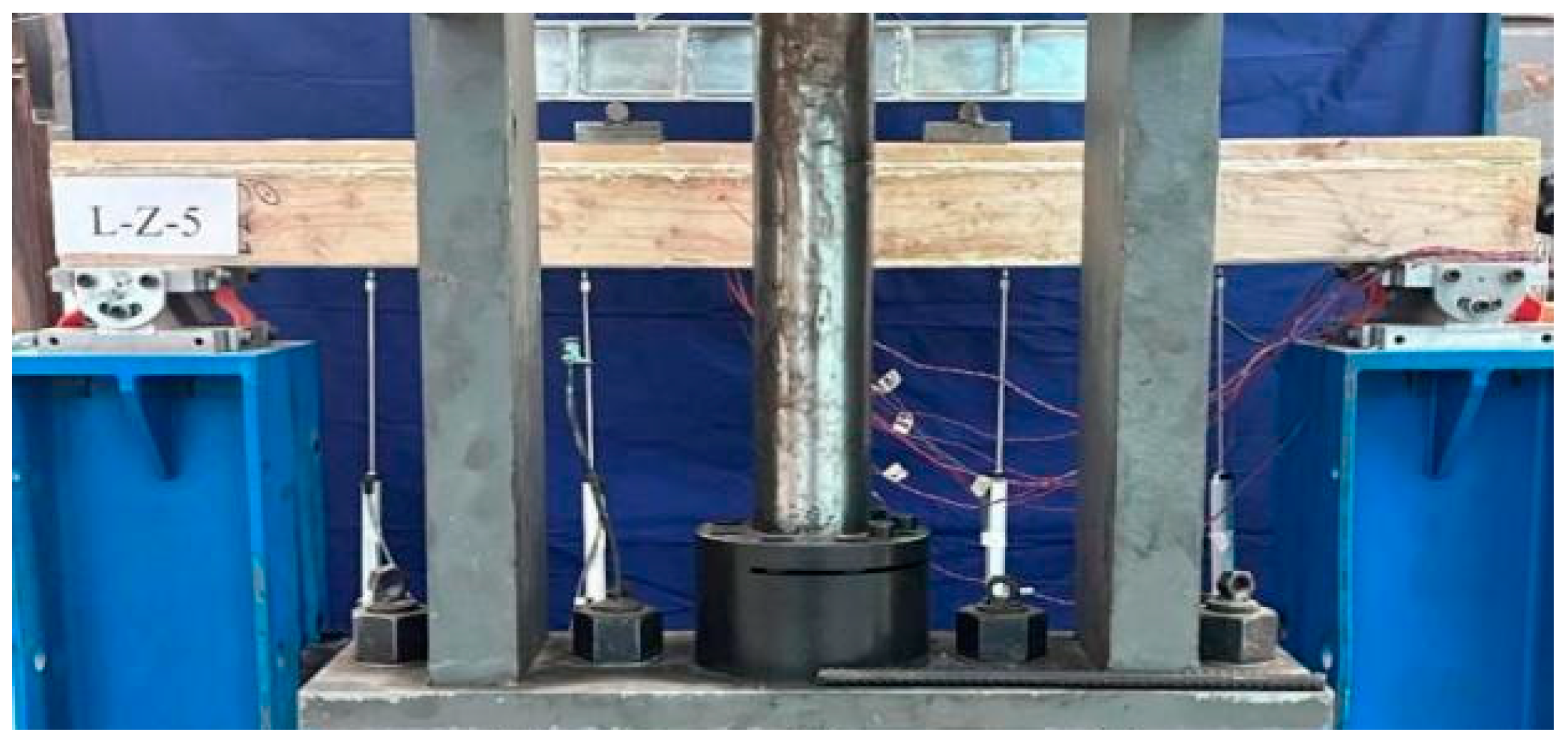
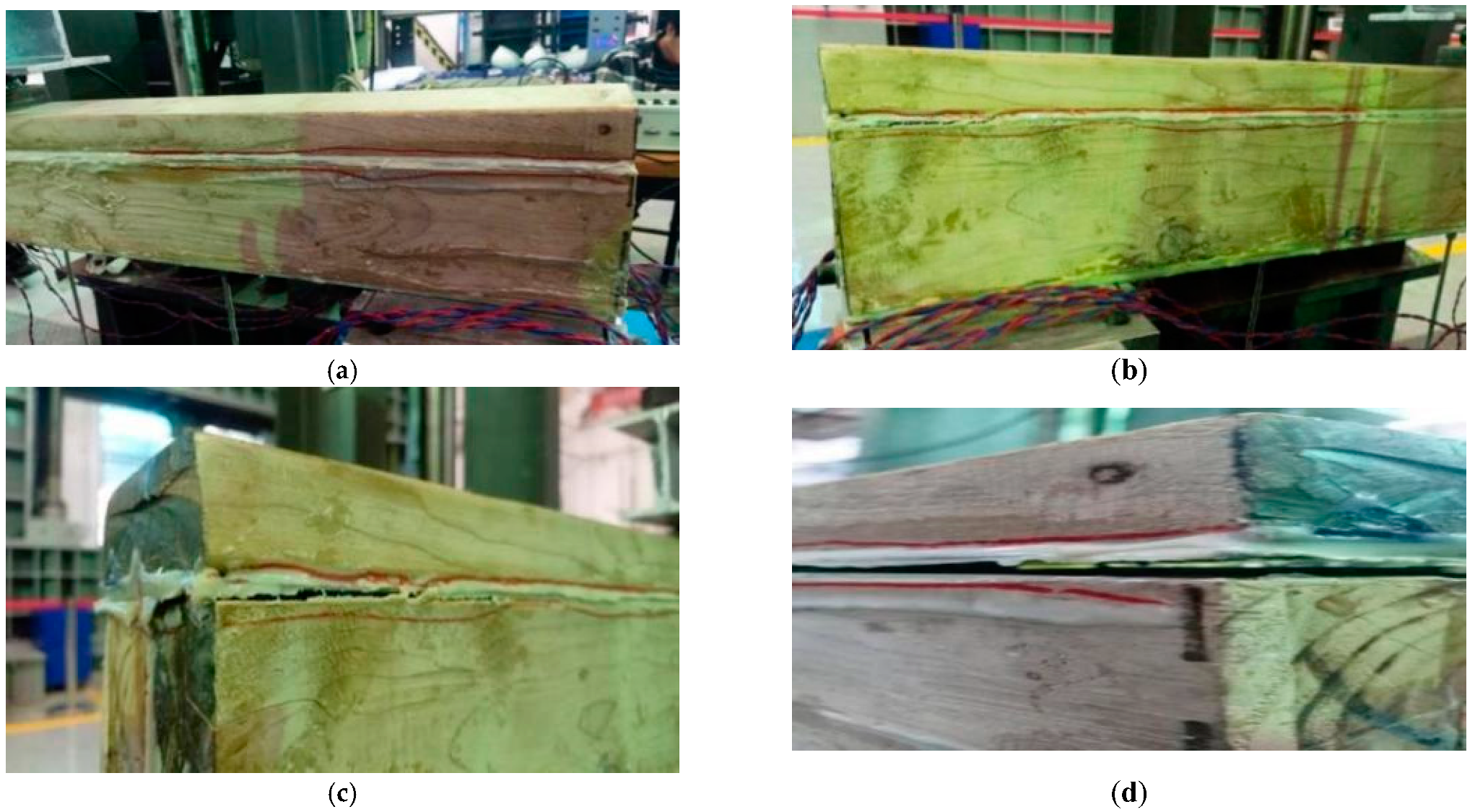

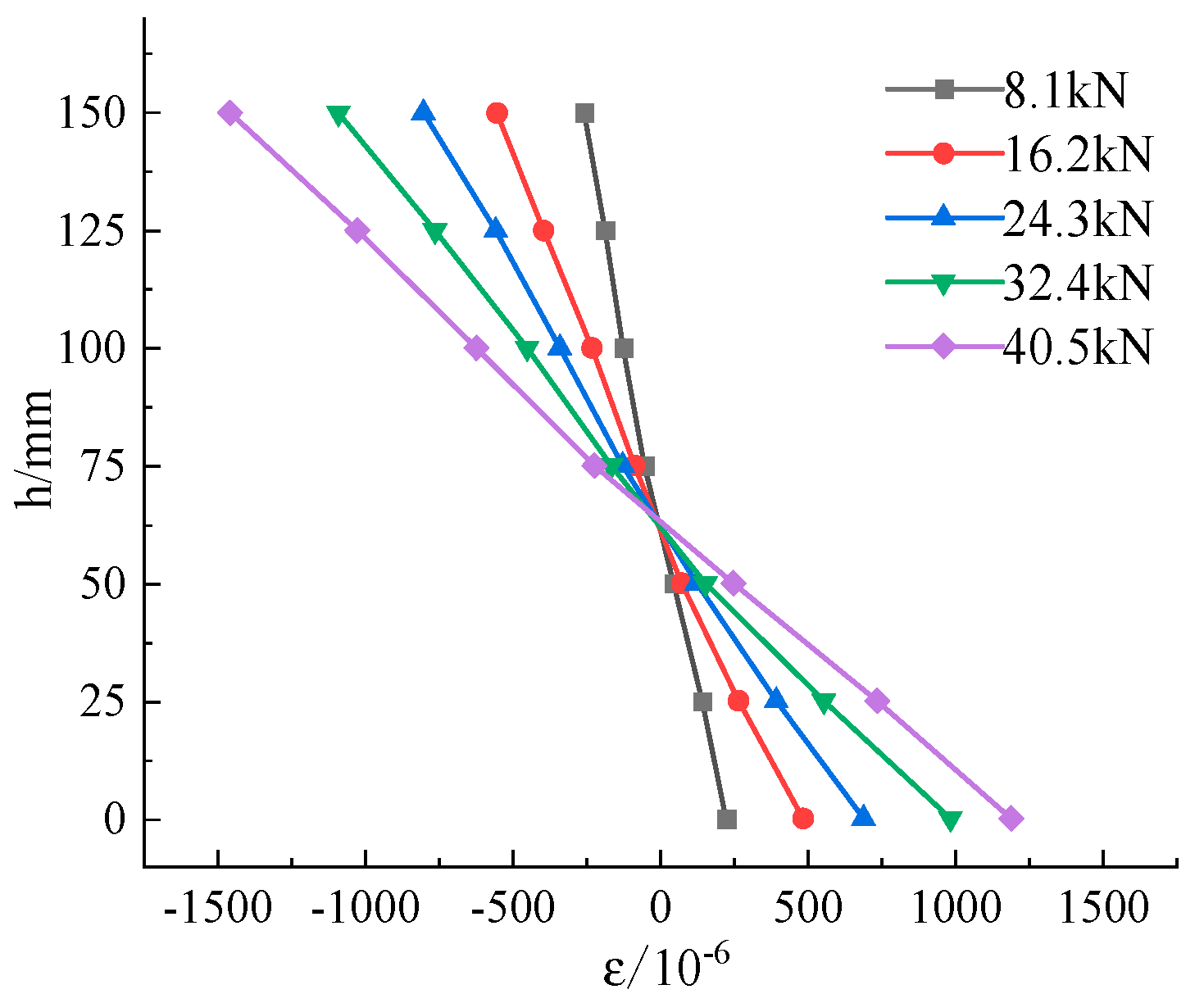
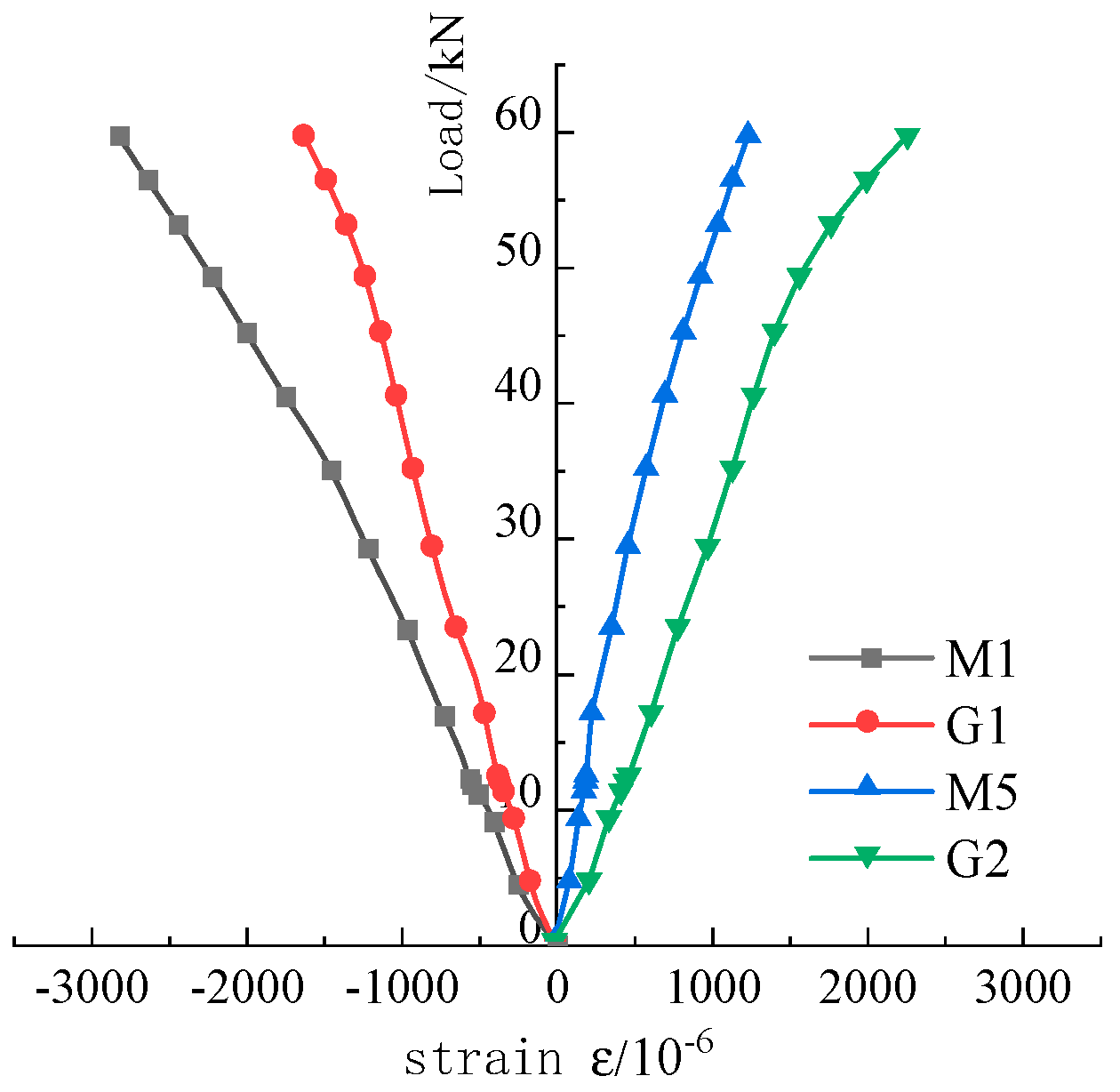
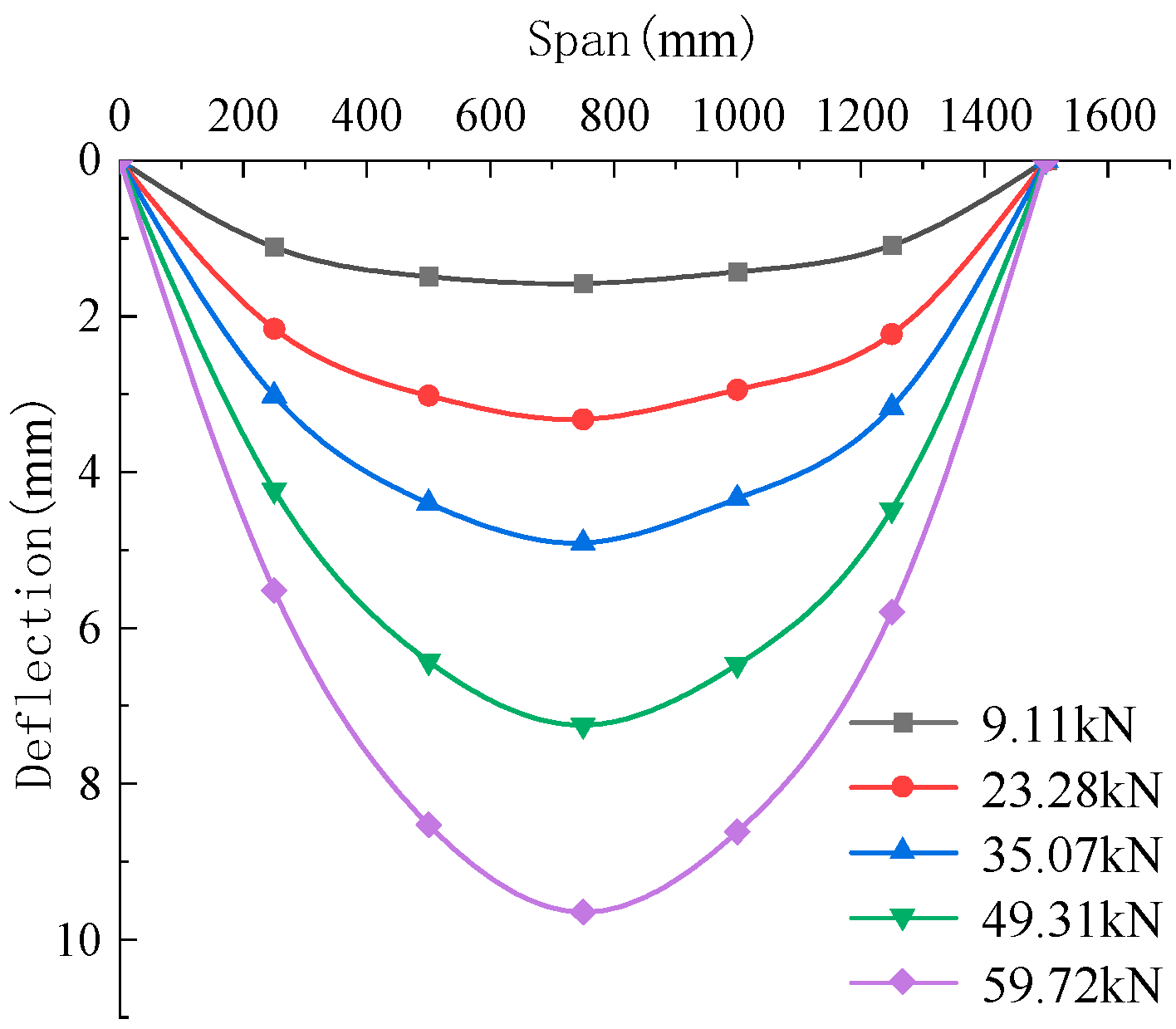
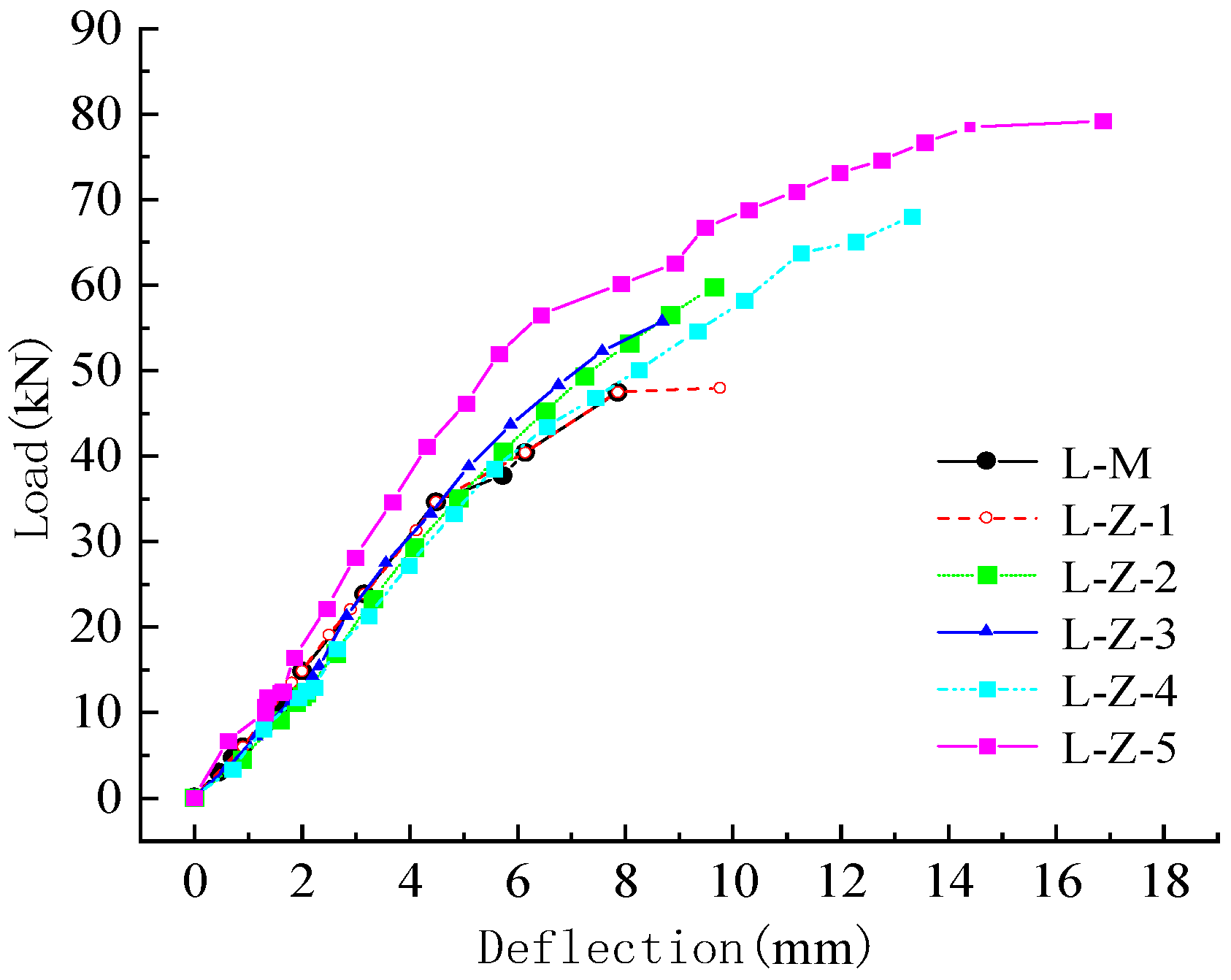
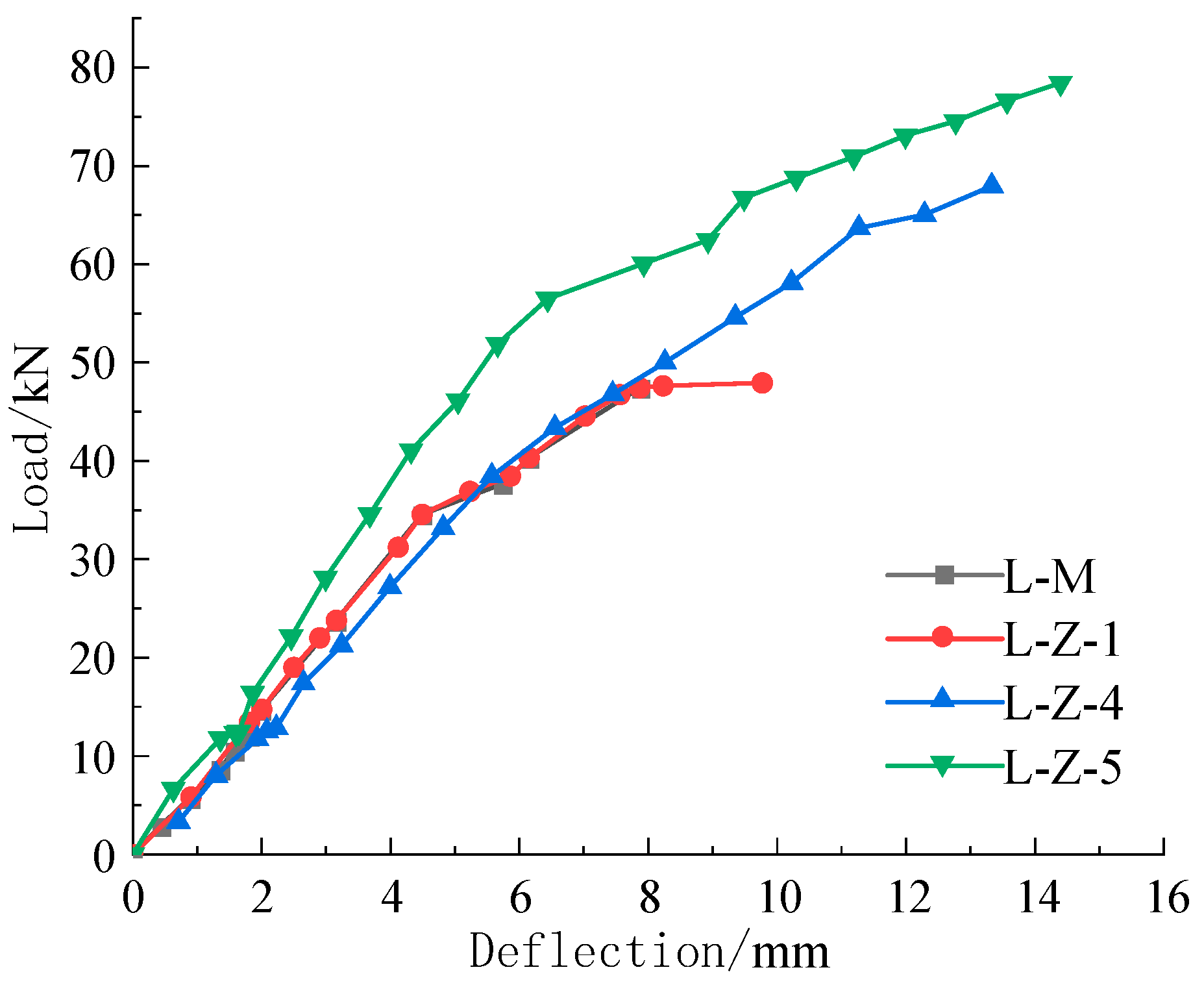
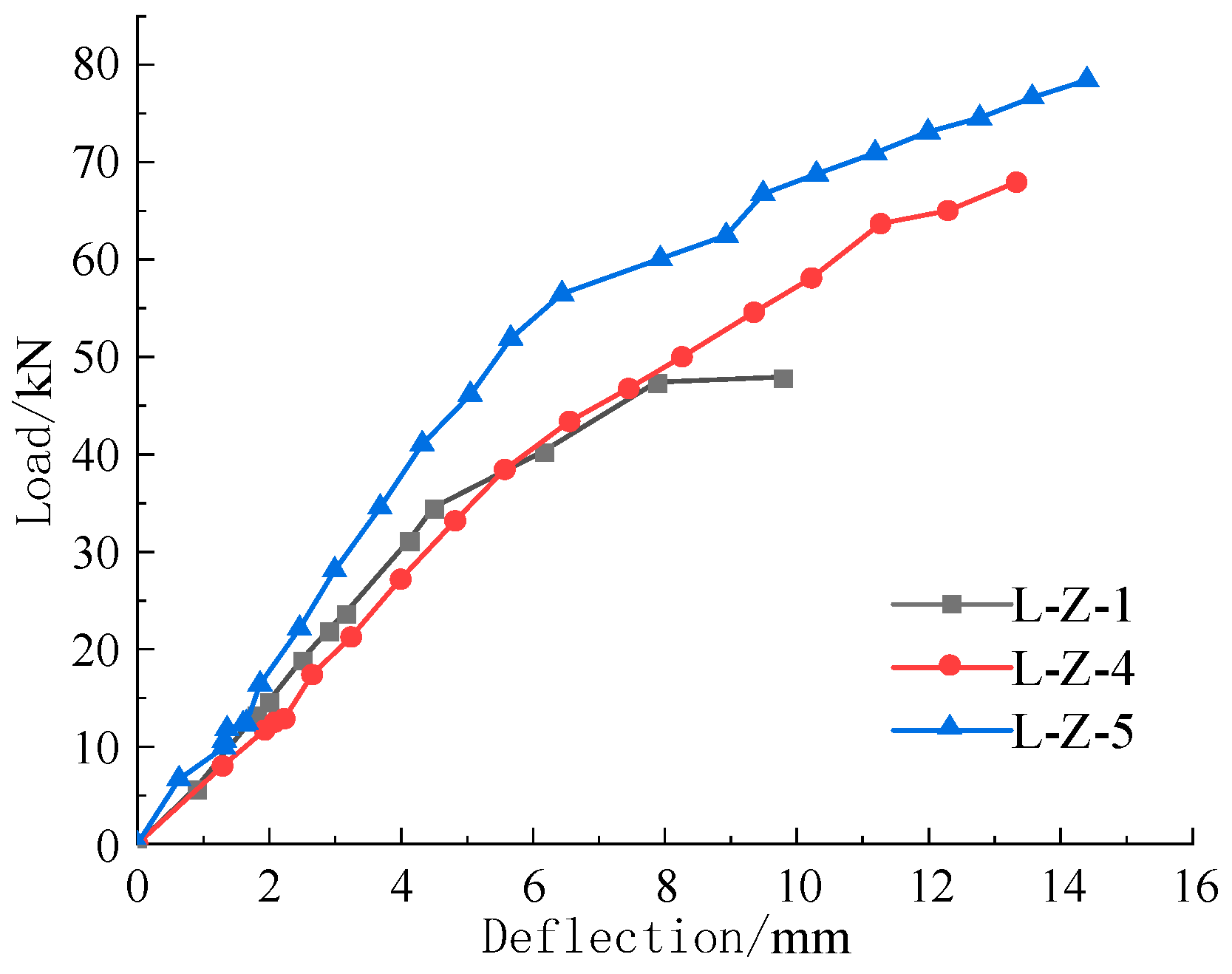
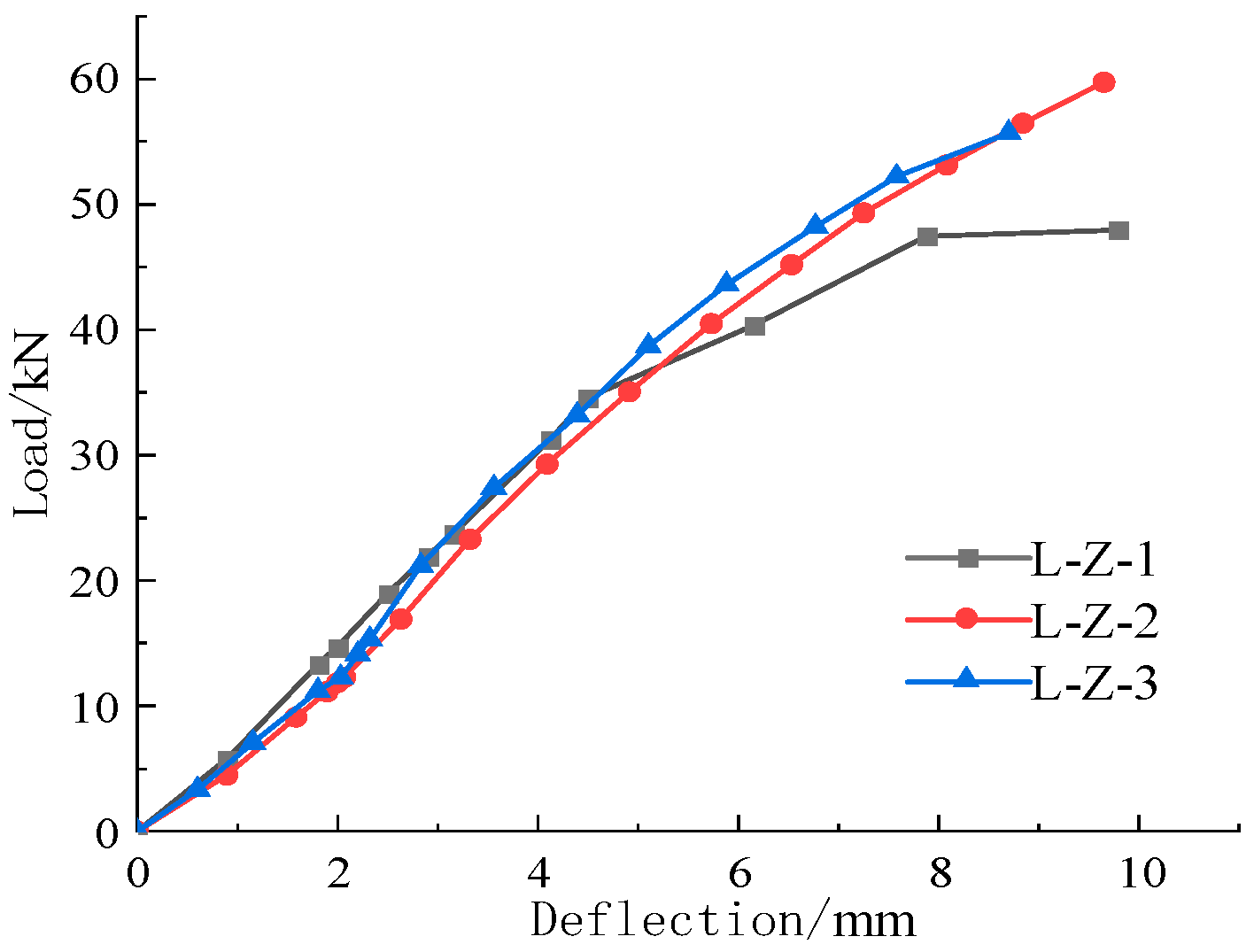
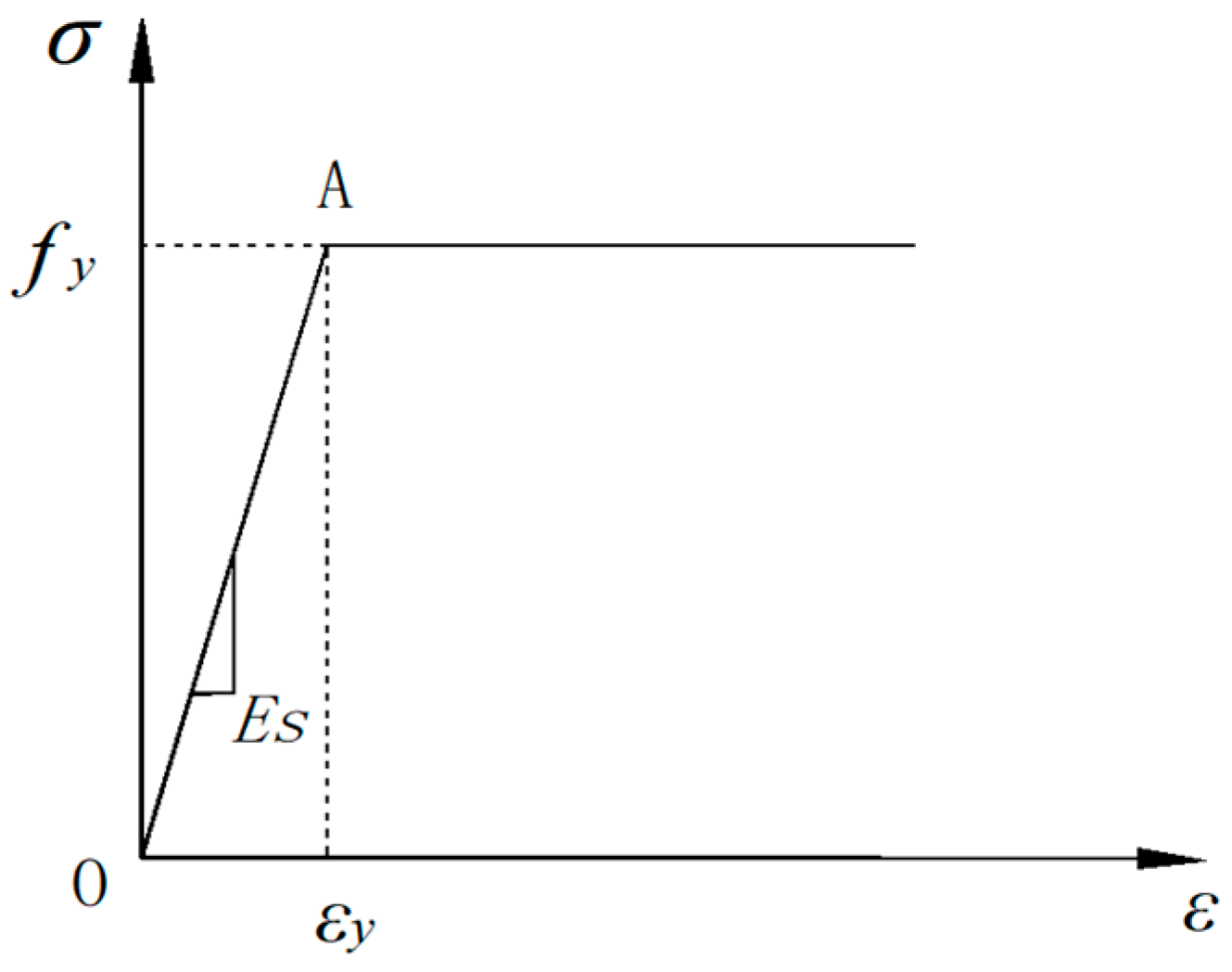
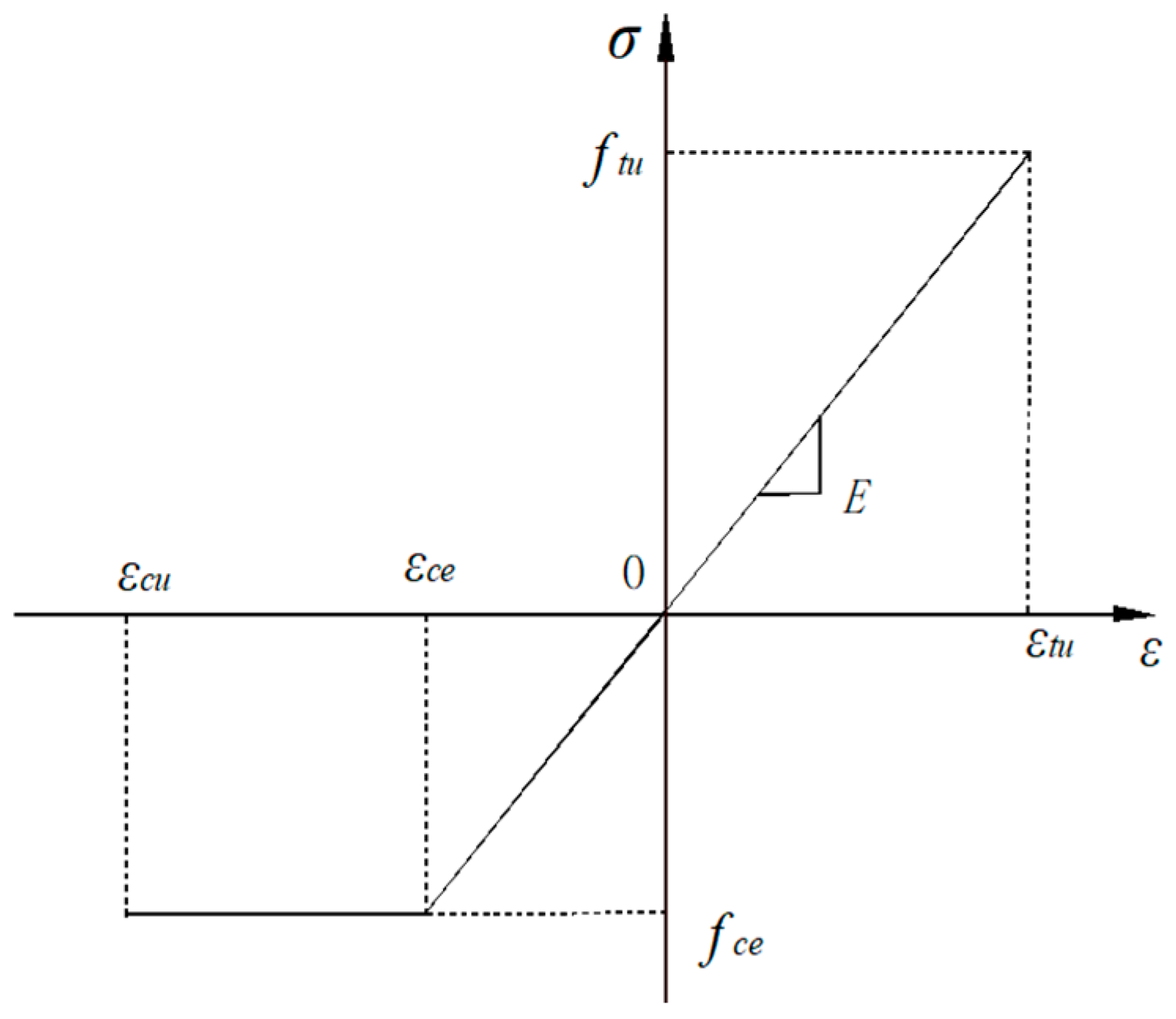
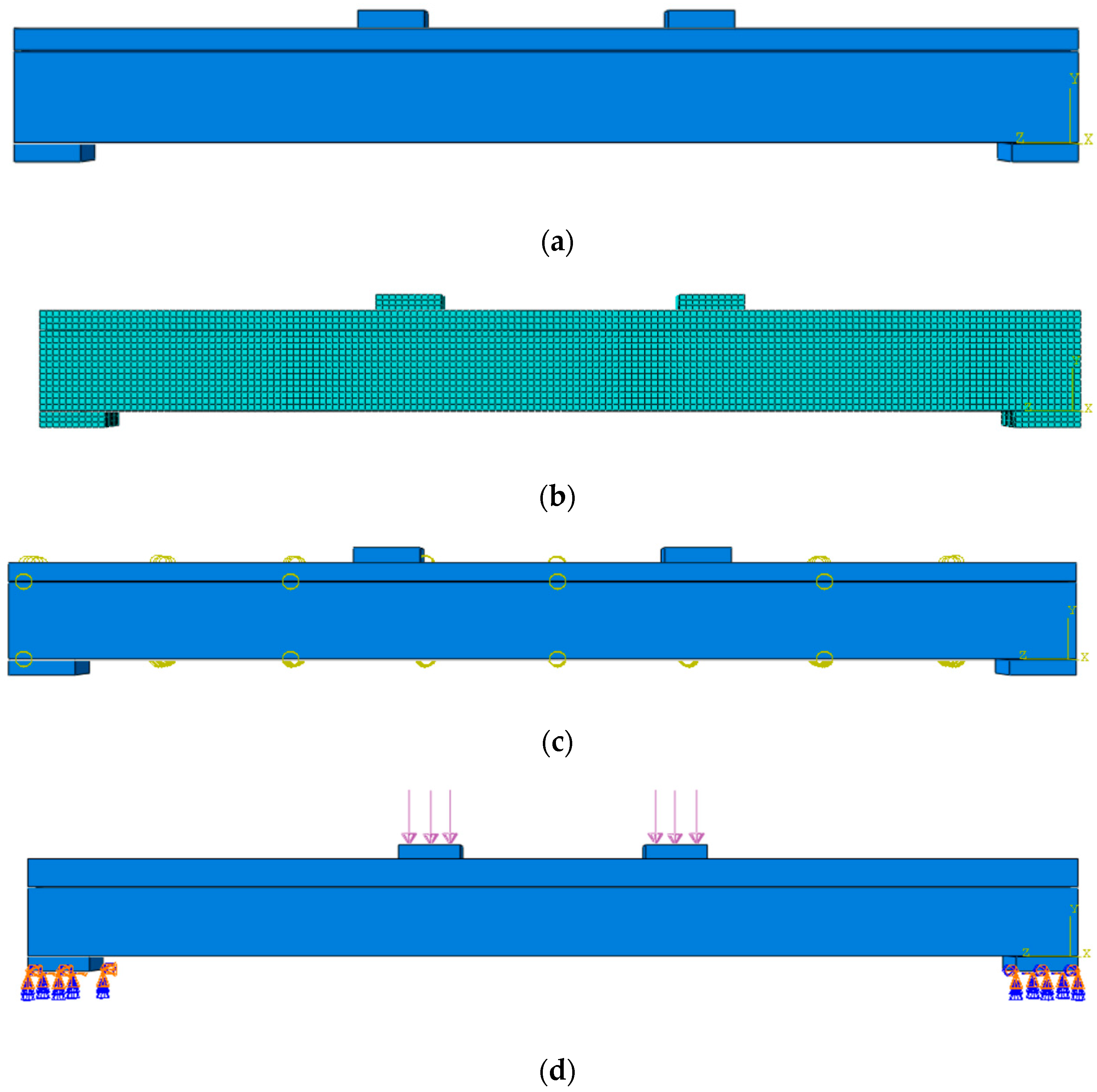
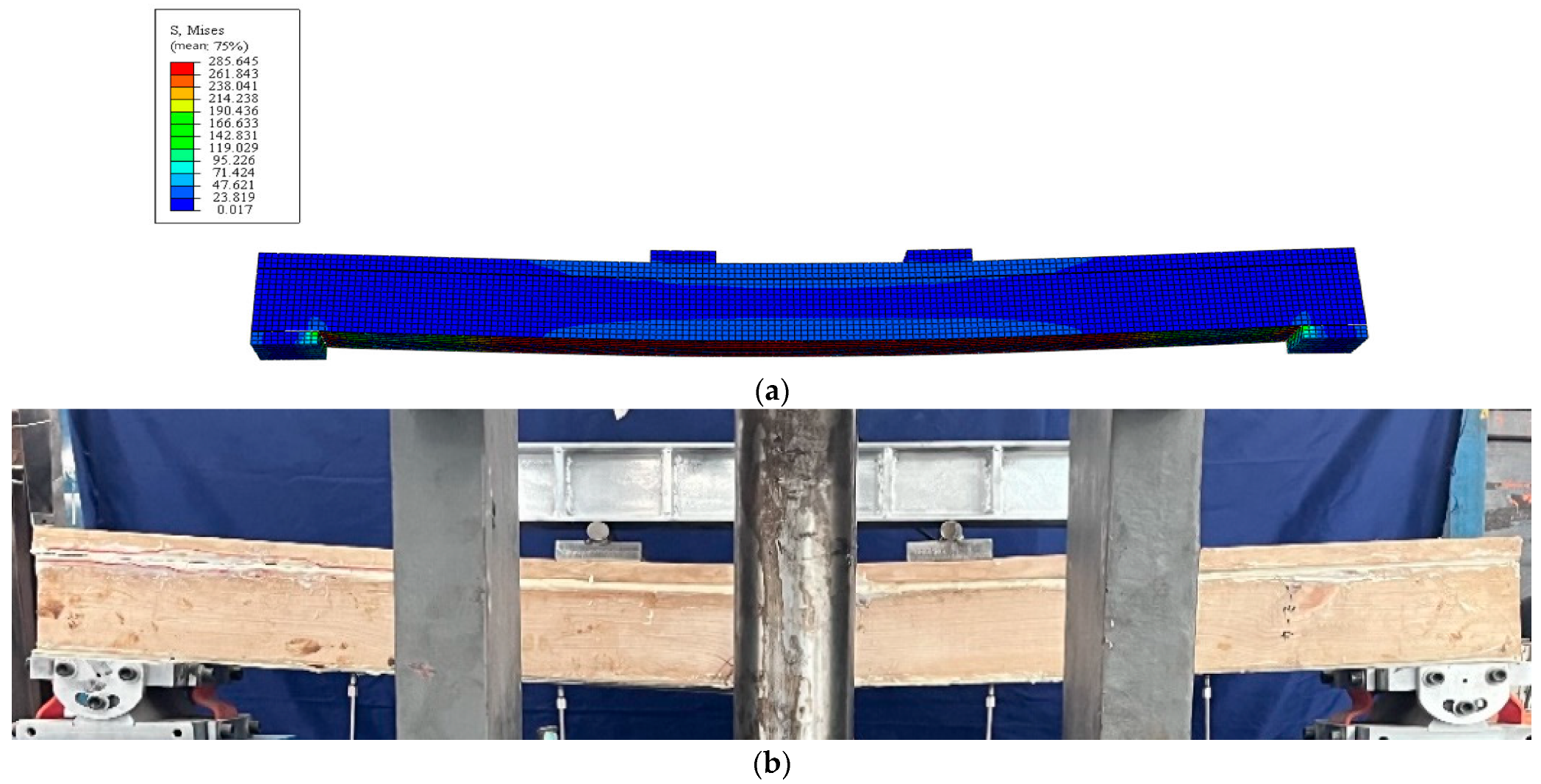
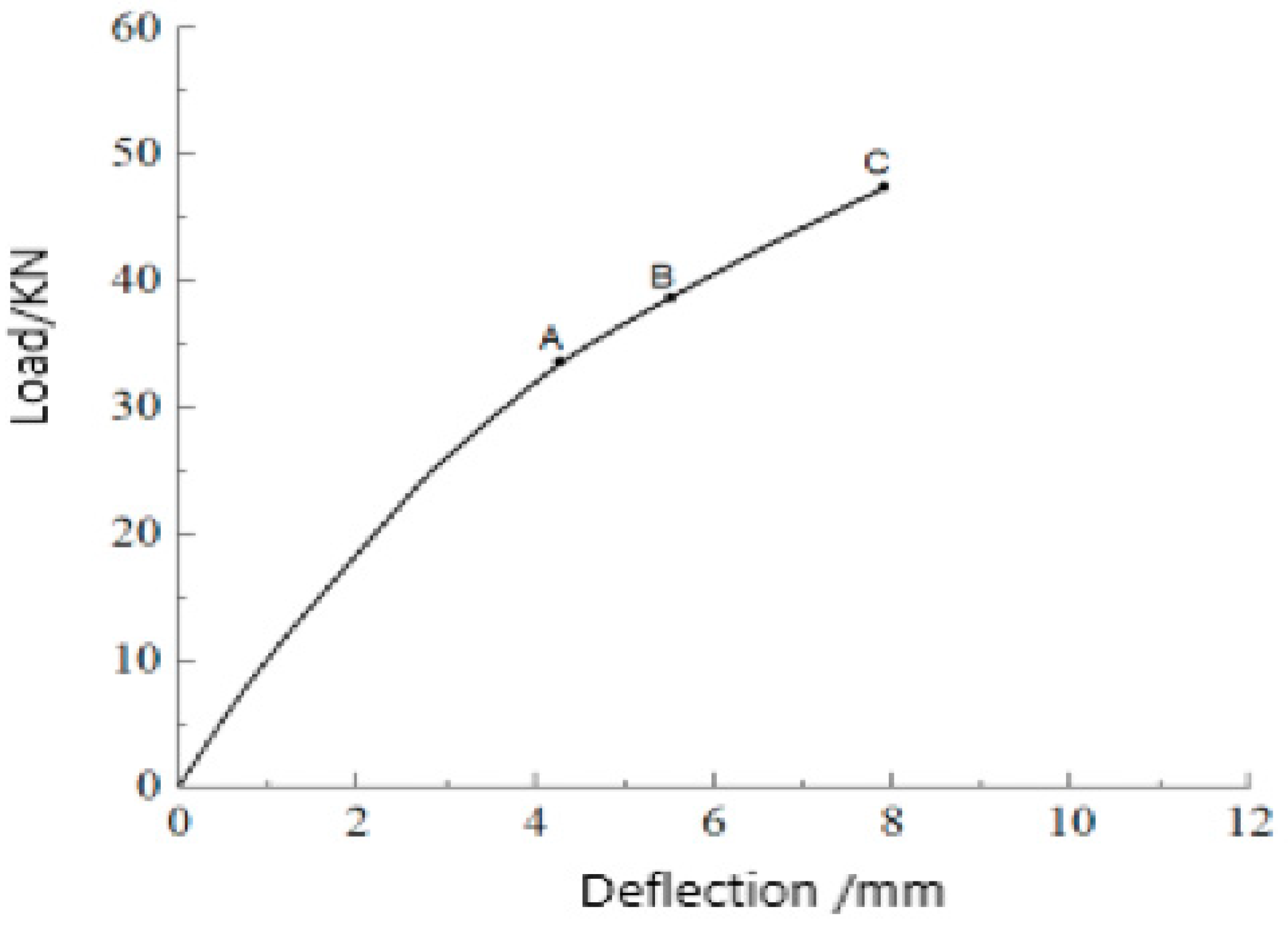
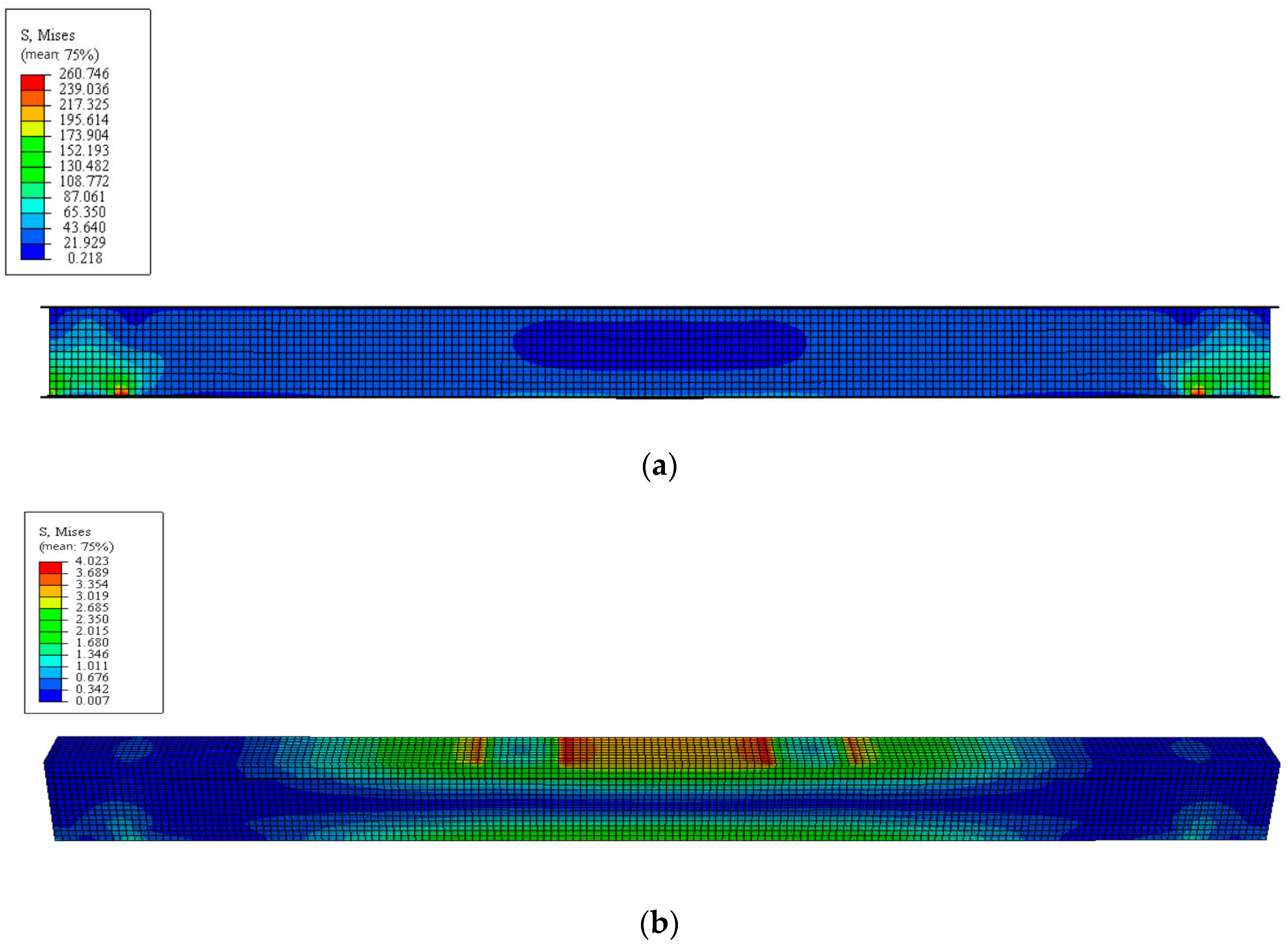
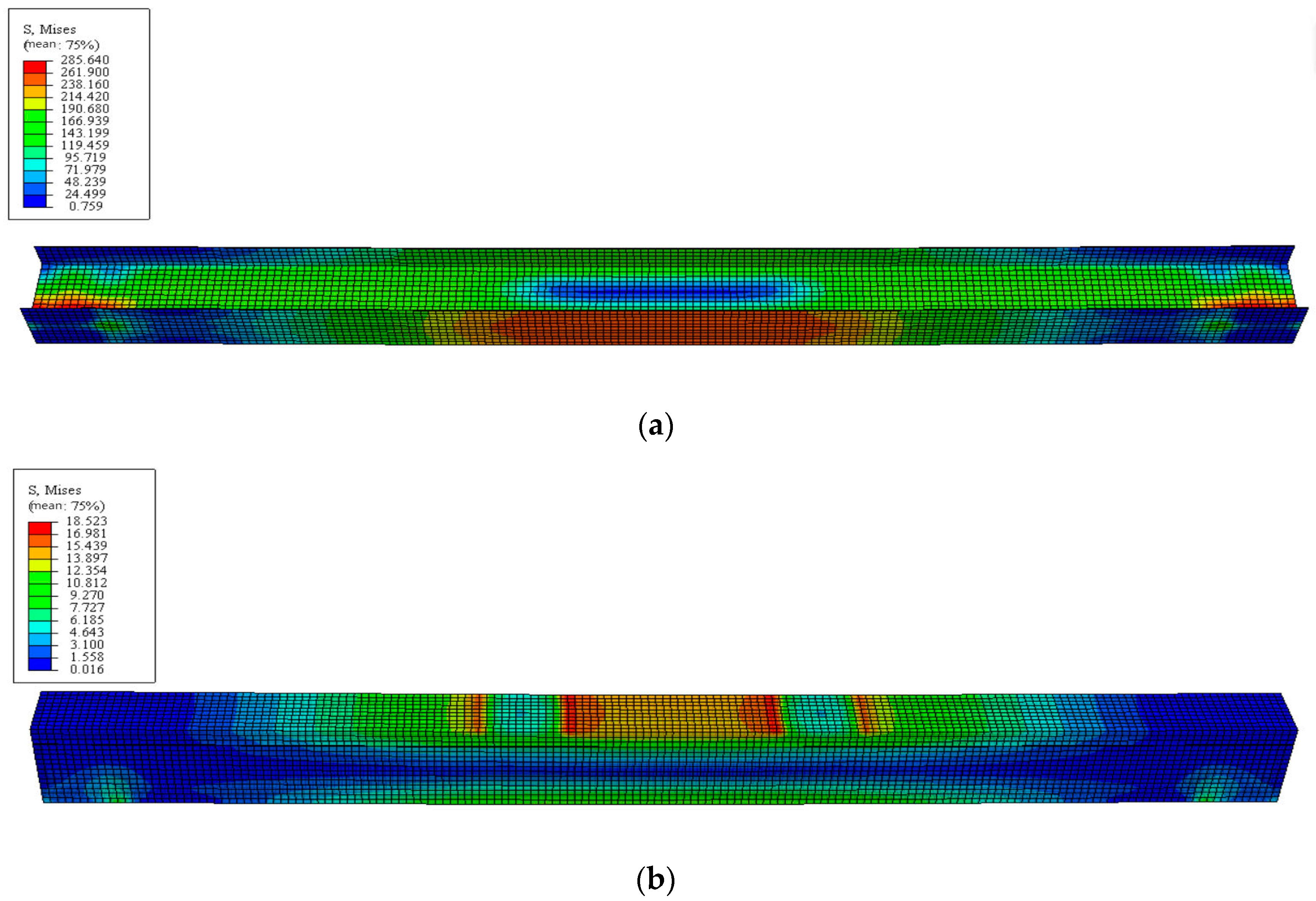

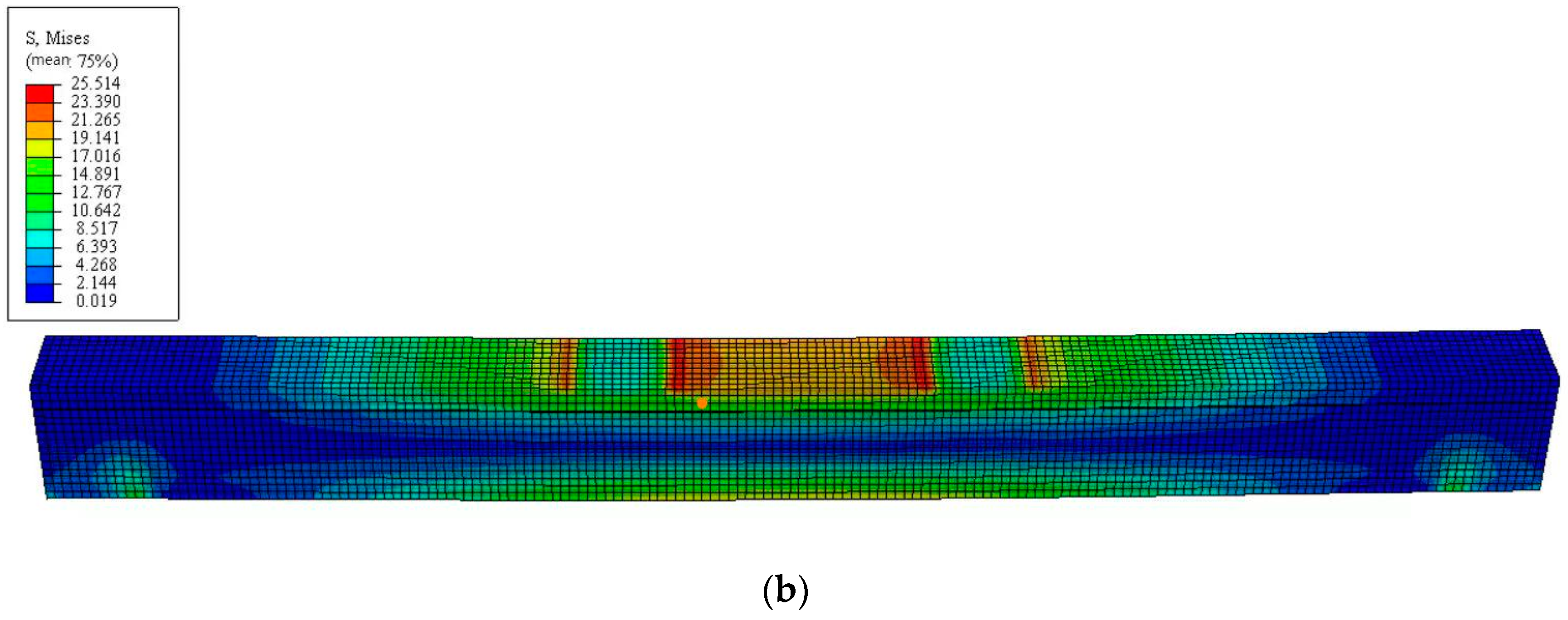

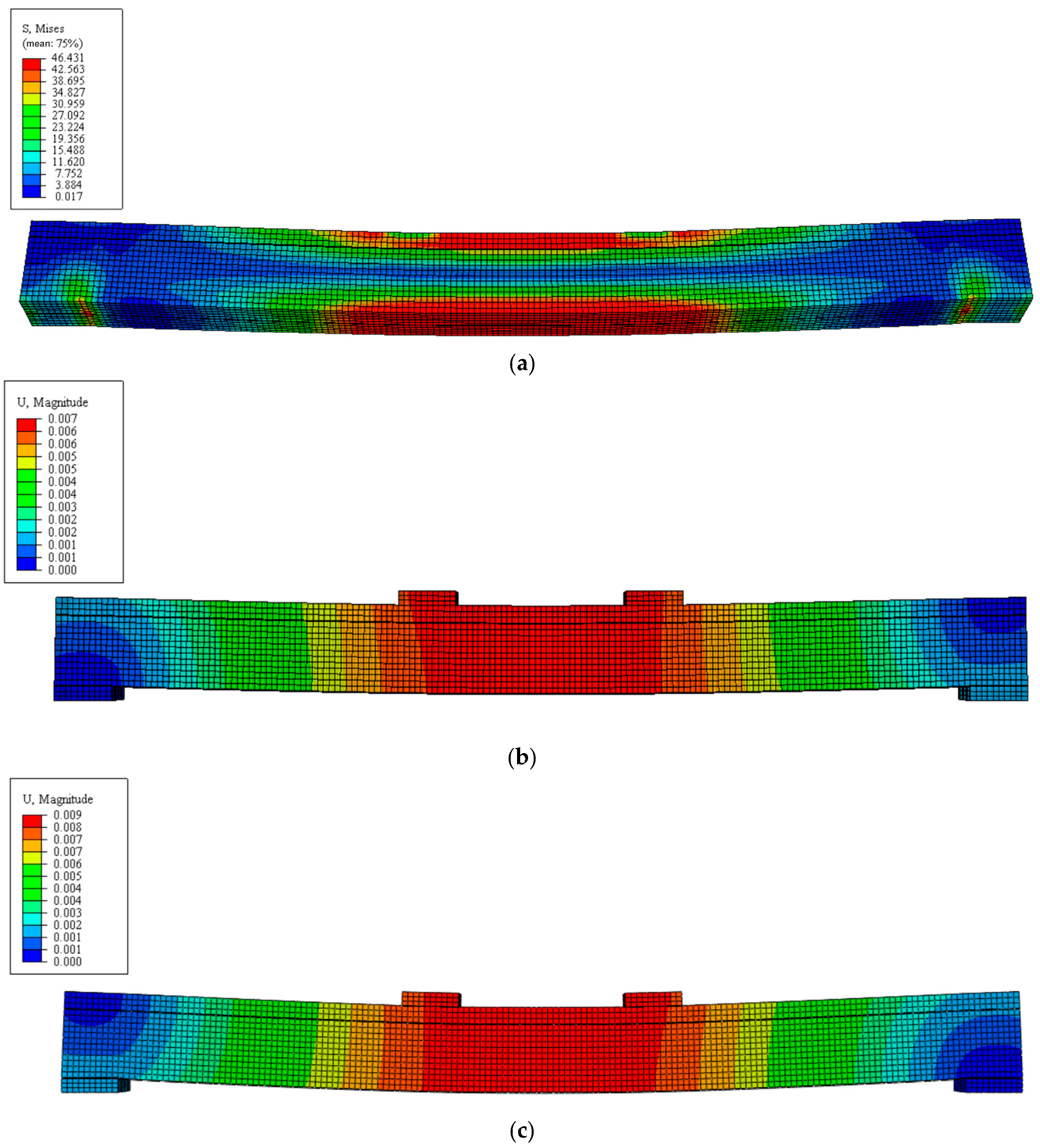
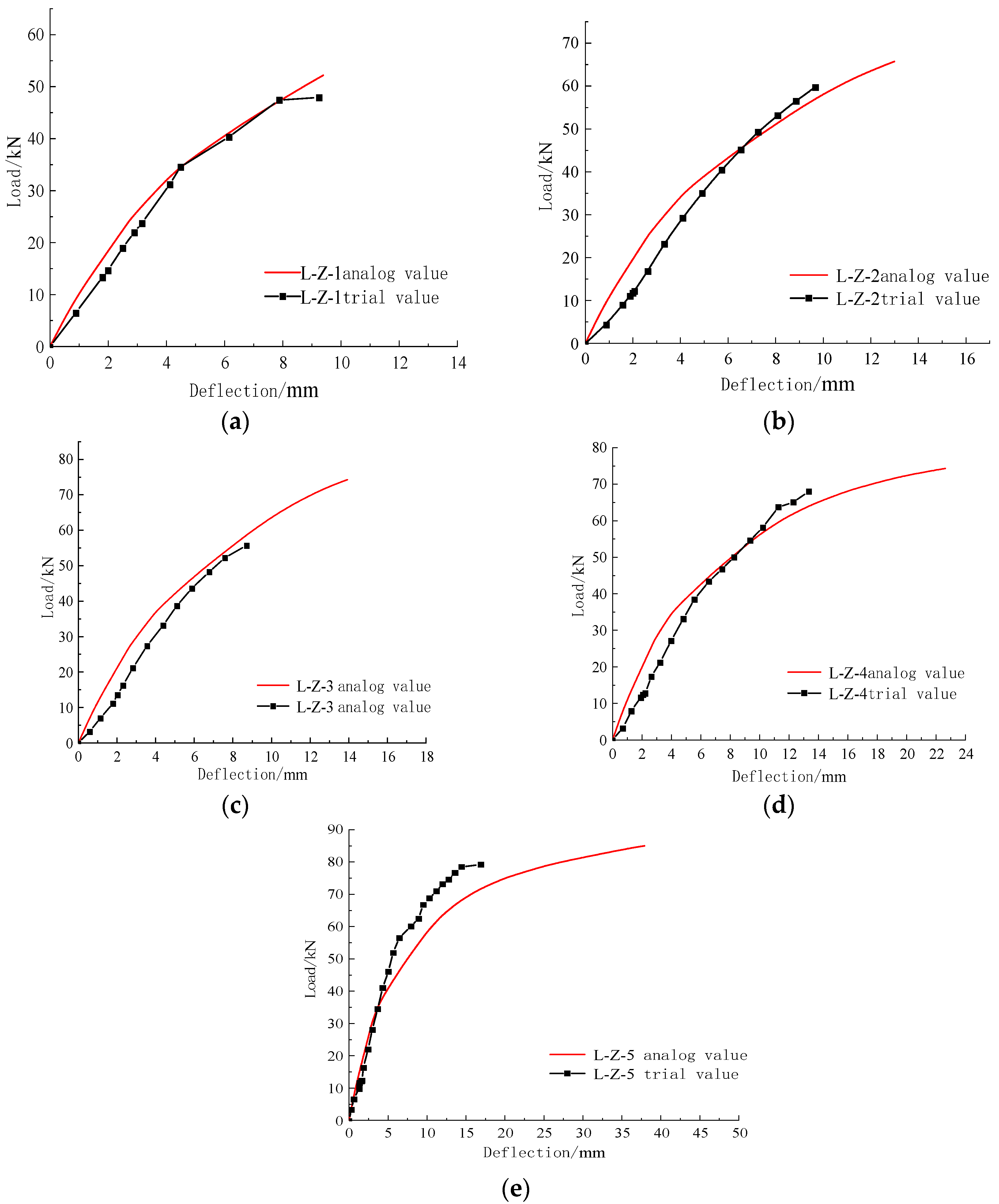
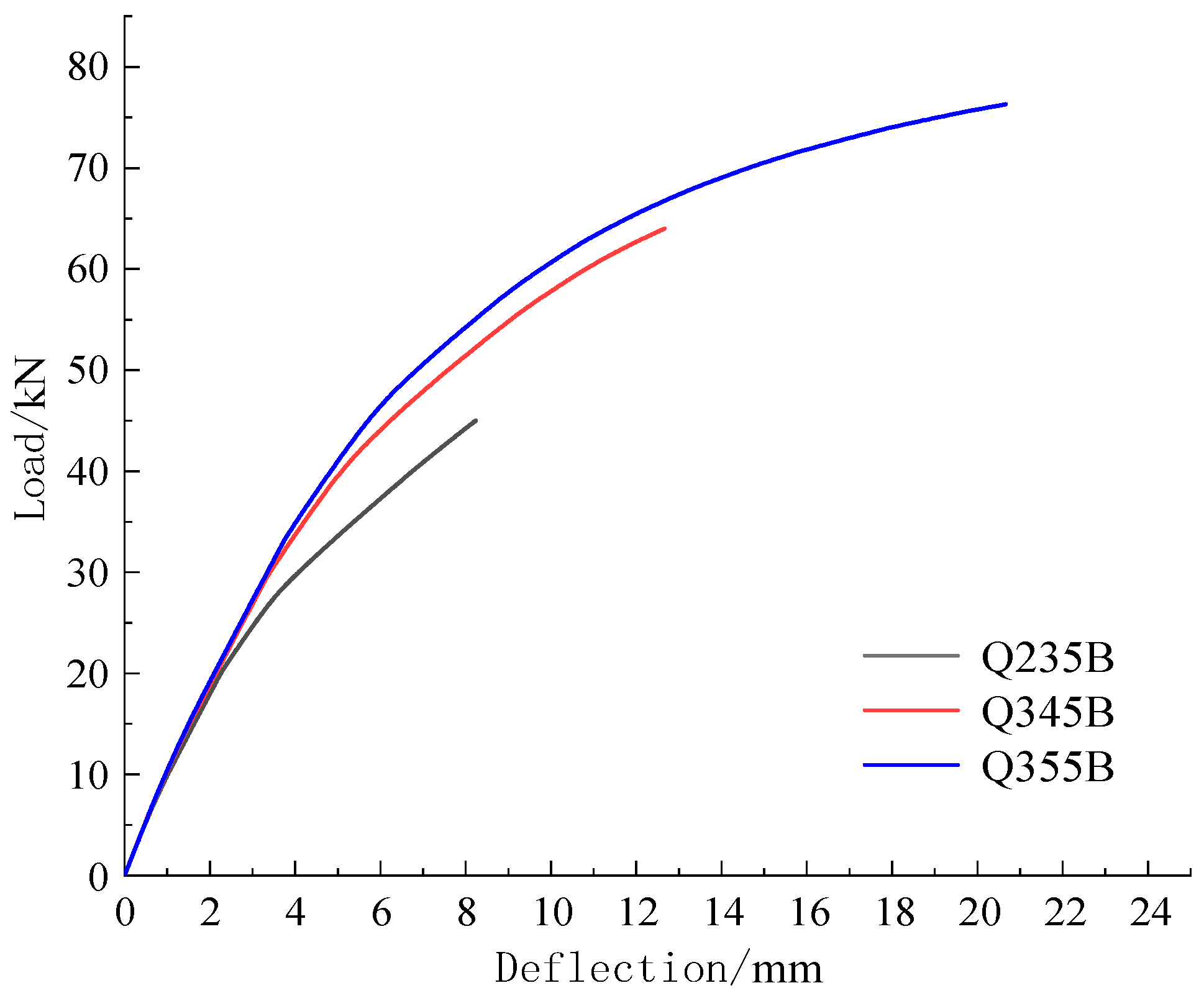
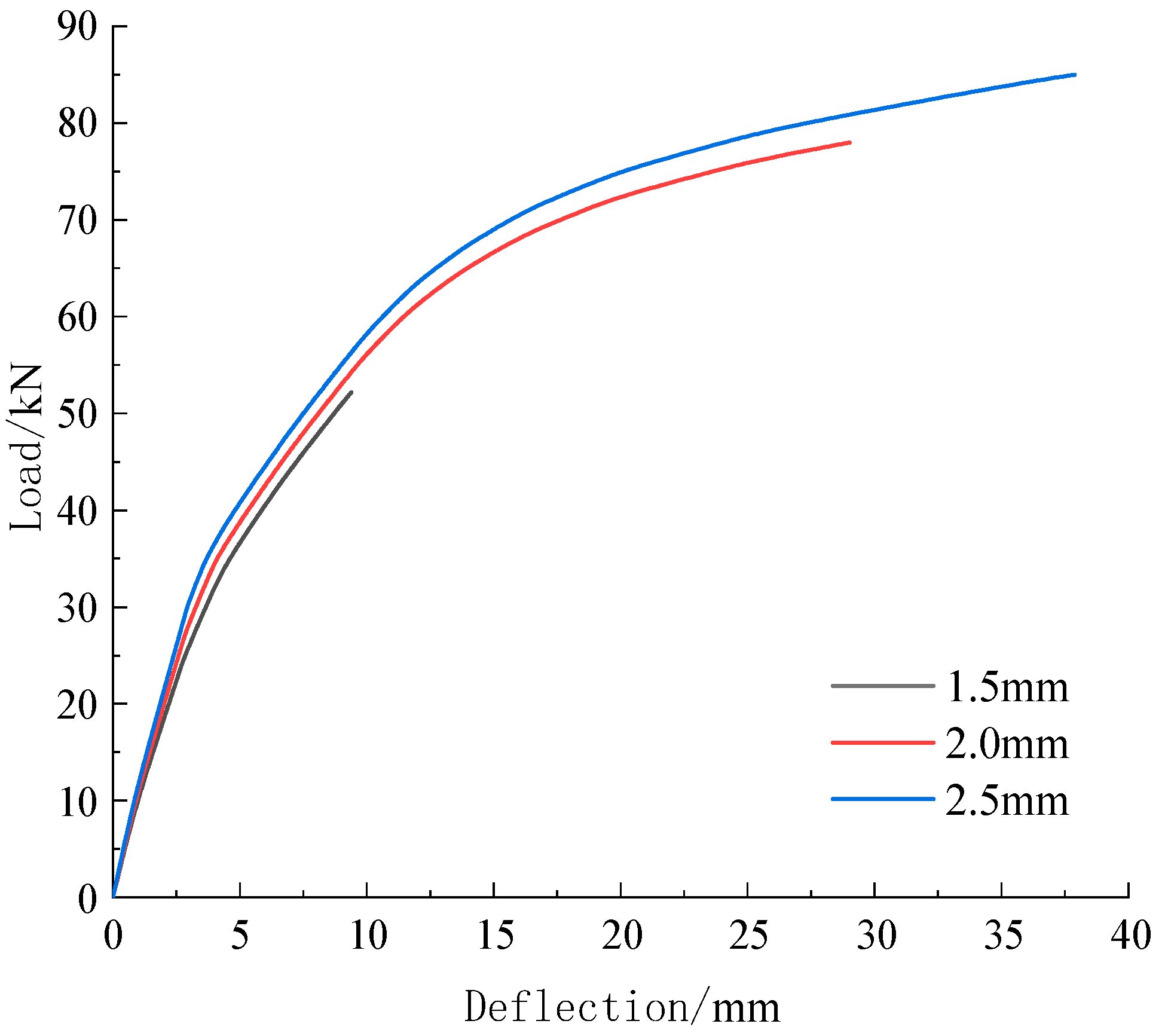
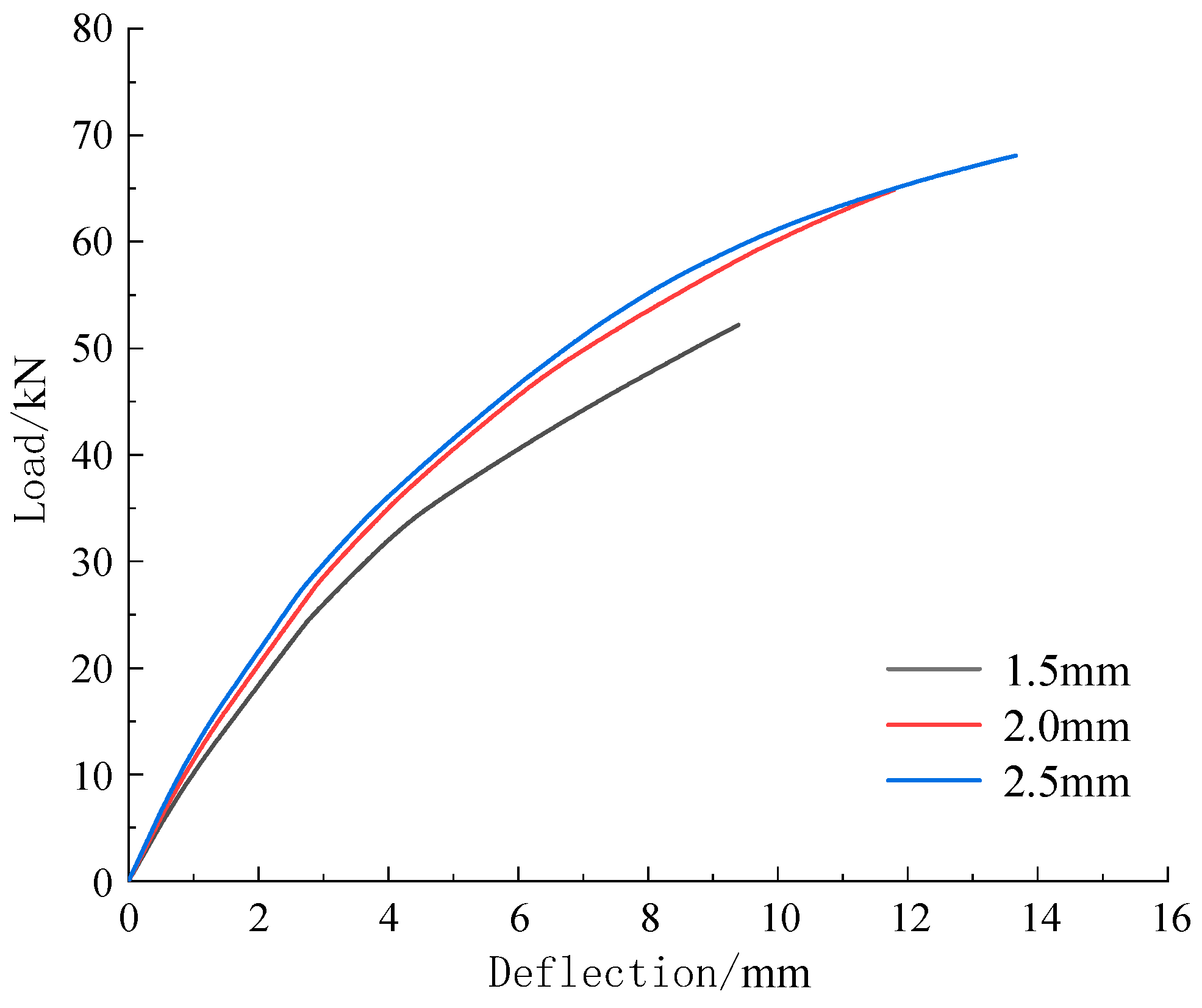
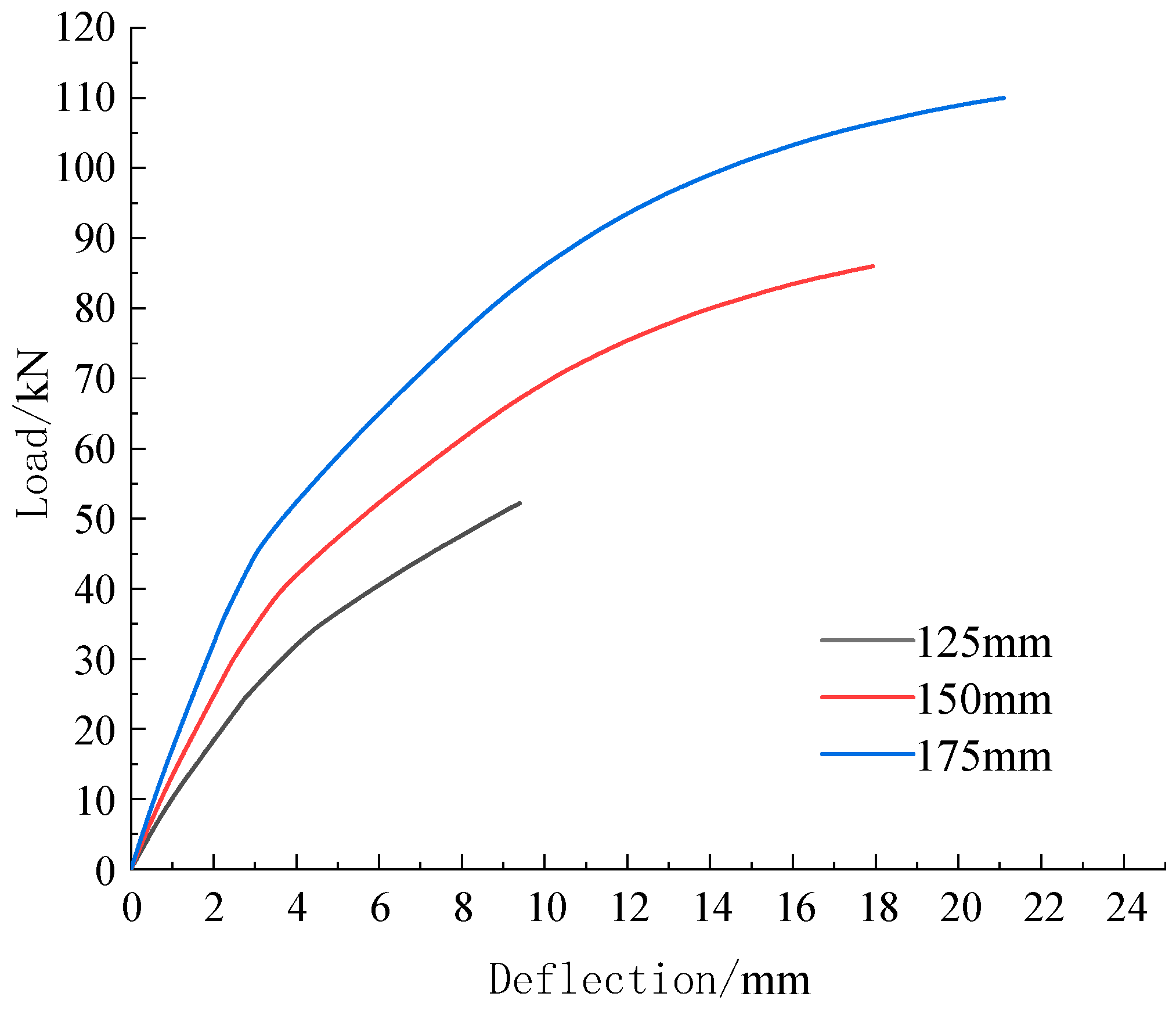
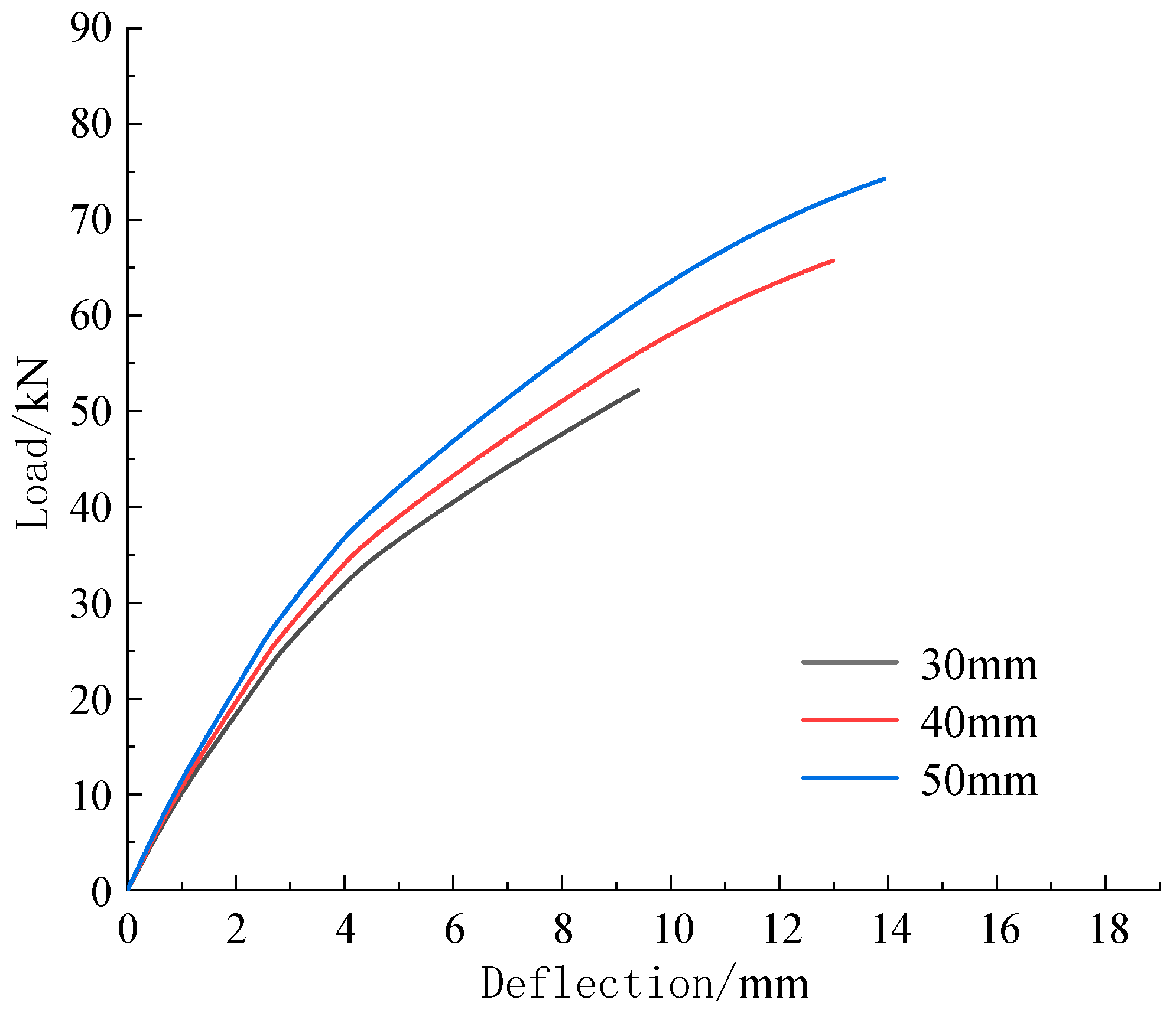
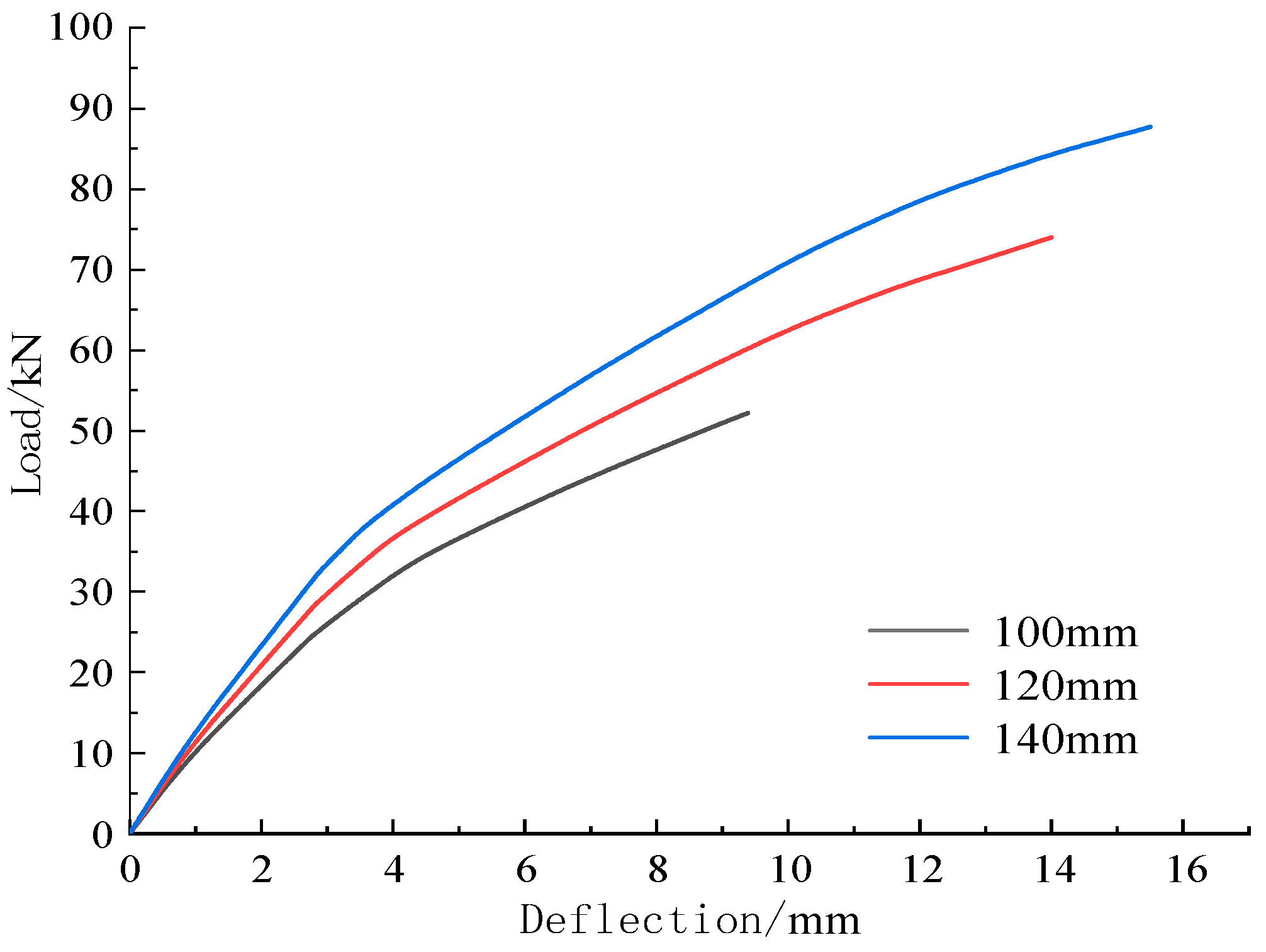
| Specimen Code | tf | tw | h1 | t1 | t2 | t3 | b1 | l | b × h |
|---|---|---|---|---|---|---|---|---|---|
| L-M | - | - | - | - | - | - | - | 1700 | 100 × 155 |
| L-Z-1 | 1.5 | 1.5 | 125 | 49.25 | 49.25 | 30 | 100 | 1700 | 100 × 155 |
| L-Z-2 | 1.5 | 1.5 | 125 | 49.25 | 49.25 | 40 | 100 | 1700 | 100 × 165 |
| L-Z-3 | 1.5 | 1.5 | 125 | 49.25 | 49.25 | 50 | 100 | 1700 | 100 × 175 |
| L-Z-4 | 2 | 1.5 | 125 | 49.25 | 49.25 | 30 | 100 | 1700 | 100 × 155 |
| L-Z-5 | 2.5 | 1.5 | 125 | 49.25 | 49.25 | 30 | 100 | 1700 | 100 × 155 |
| Specimen Number | P/kN | γP/% |
|---|---|---|
| L-M | 47.429 | - |
| L-Z-1 | 47.934 | 1.06 |
| L-Z-4 | 67.958 | 42 |
| L-Z-5 | 79.169 | 68.87 |
| Specimen Number | H-Beam Flange Thickness/mm | P/kN | γP/% |
|---|---|---|---|
| L-Z-1 | 1.5 | 47.934 | — |
| L-Z-4 | 2 | 67.958 | 41.77 |
| L-Z-5 | 2.5 | 79.169 | 16.5 |
| EL (MPa) | ER (MPa) | ET (MPa) | μRT | μLR | μLT | GLT | GLR | GRT |
|---|---|---|---|---|---|---|---|---|
| 11,022 | 1102.2 | 551.1 | 0.37 | 0.022 | 0.37 | 661.32 | 826.65 | 198.40 |
Disclaimer/Publisher’s Note: The statements, opinions and data contained in all publications are solely those of the individual author(s) and contributor(s) and not of MDPI and/or the editor(s). MDPI and/or the editor(s) disclaim responsibility for any injury to people or property resulting from any ideas, methods, instructions or products referred to in the content. |
© 2023 by the authors. Licensee MDPI, Basel, Switzerland. This article is an open access article distributed under the terms and conditions of the Creative Commons Attribution (CC BY) license (https://creativecommons.org/licenses/by/4.0/).
Share and Cite
Wu, C.; Duan, J.; Yang, Z.; Zhao, Z.; Xu, Y. A Novel Rectangular-Section Combined Beam of Welded Thin-Walled H-Shape Steel/Camphor Pine Wood: The Bending Performance Study. Sustainability 2023, 15, 7450. https://doi.org/10.3390/su15097450
Wu C, Duan J, Yang Z, Zhao Z, Xu Y. A Novel Rectangular-Section Combined Beam of Welded Thin-Walled H-Shape Steel/Camphor Pine Wood: The Bending Performance Study. Sustainability. 2023; 15(9):7450. https://doi.org/10.3390/su15097450
Chicago/Turabian StyleWu, Chang, Junwei Duan, Ziheng Yang, Zhijiang Zhao, and Yegong Xu. 2023. "A Novel Rectangular-Section Combined Beam of Welded Thin-Walled H-Shape Steel/Camphor Pine Wood: The Bending Performance Study" Sustainability 15, no. 9: 7450. https://doi.org/10.3390/su15097450
APA StyleWu, C., Duan, J., Yang, Z., Zhao, Z., & Xu, Y. (2023). A Novel Rectangular-Section Combined Beam of Welded Thin-Walled H-Shape Steel/Camphor Pine Wood: The Bending Performance Study. Sustainability, 15(9), 7450. https://doi.org/10.3390/su15097450





